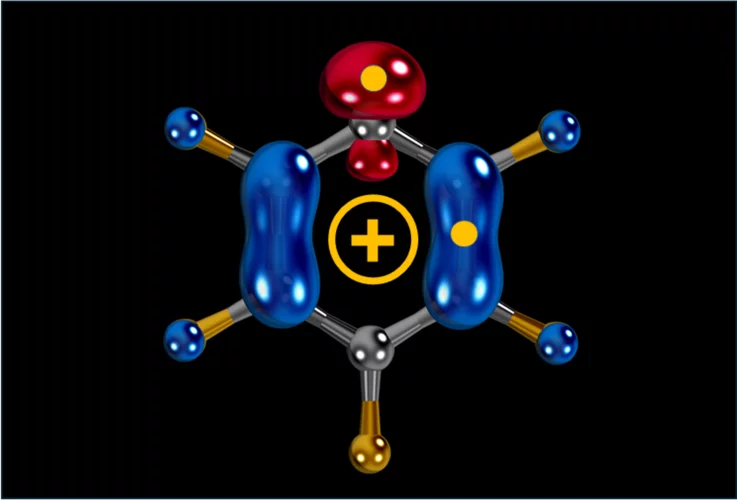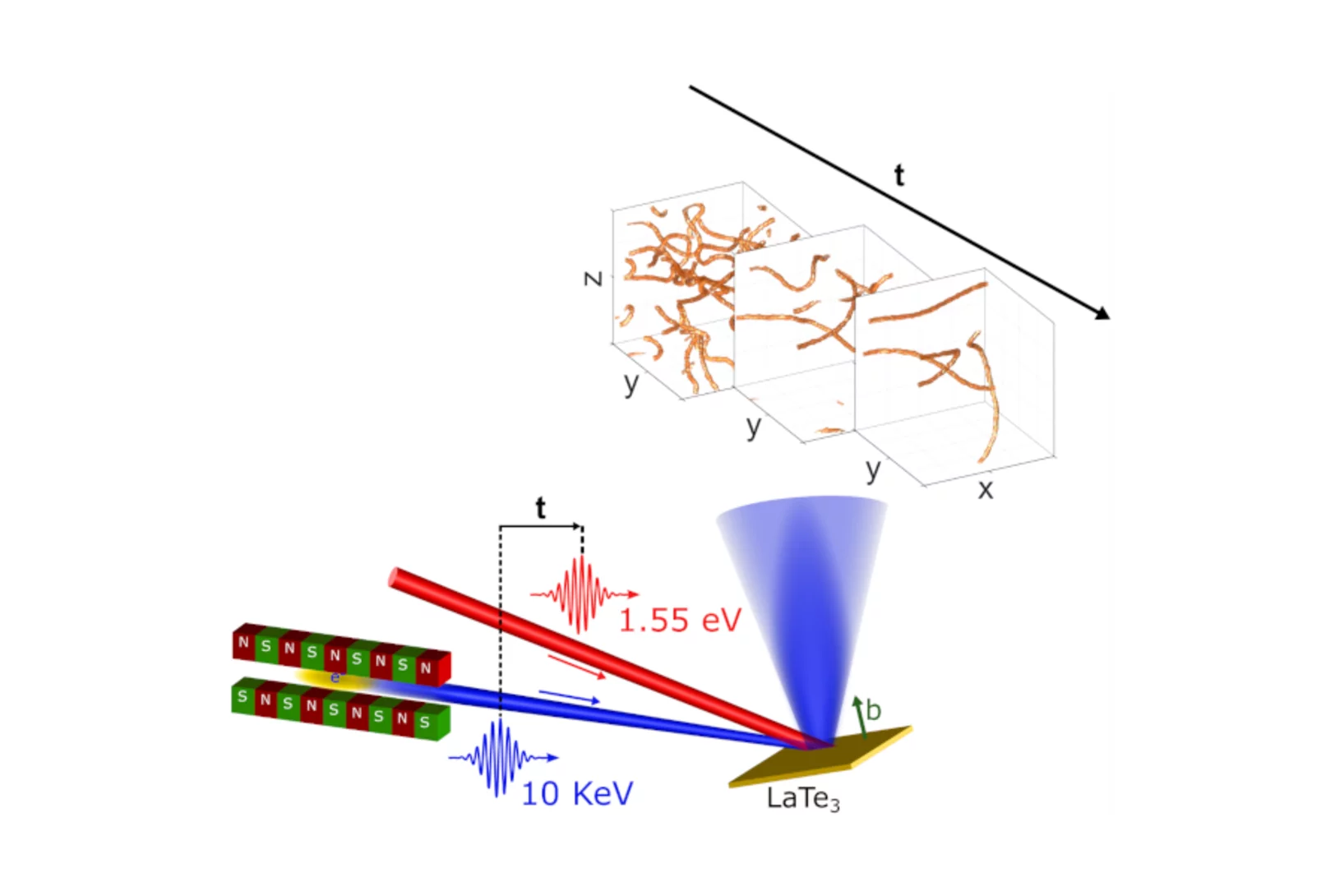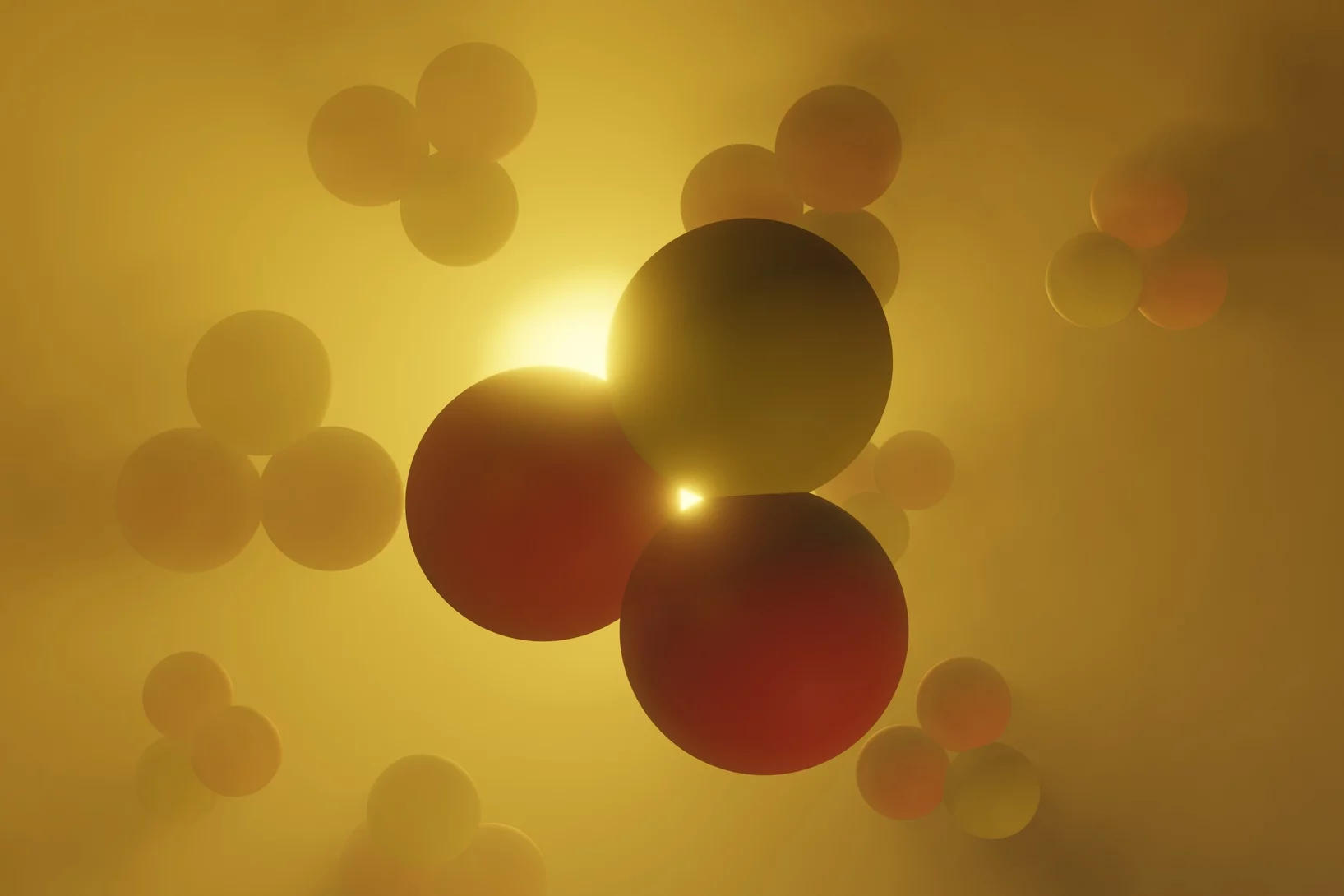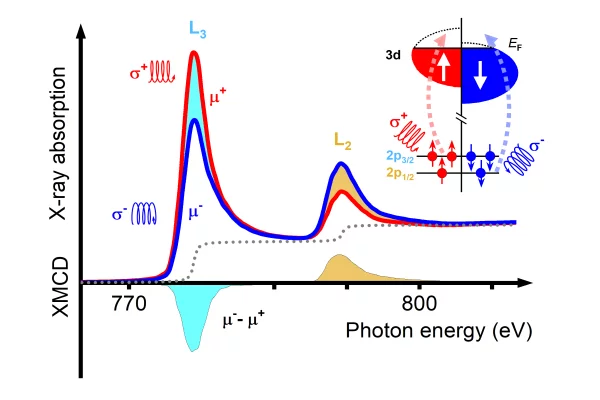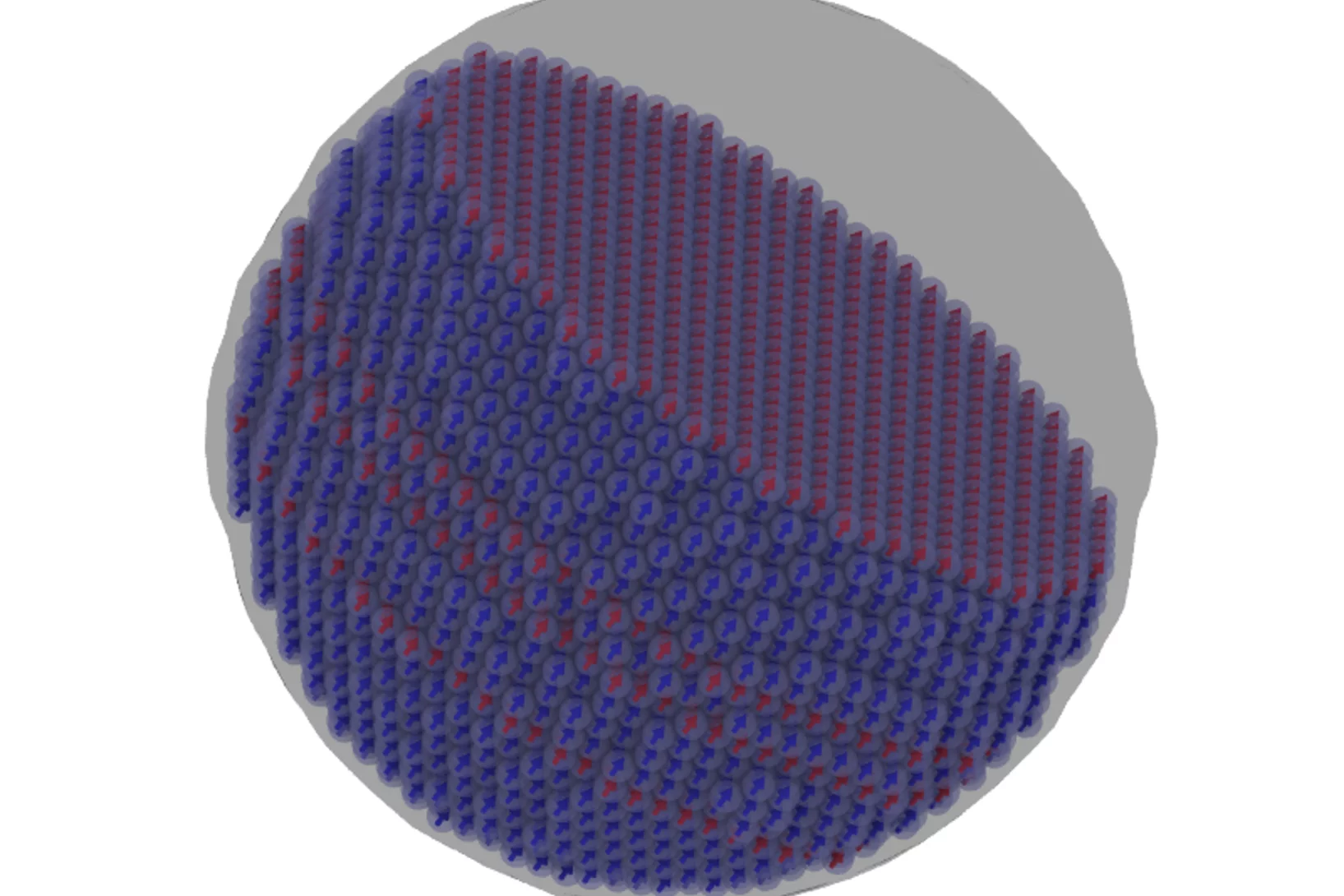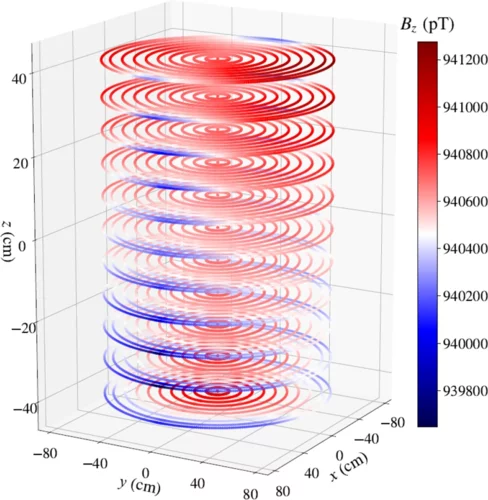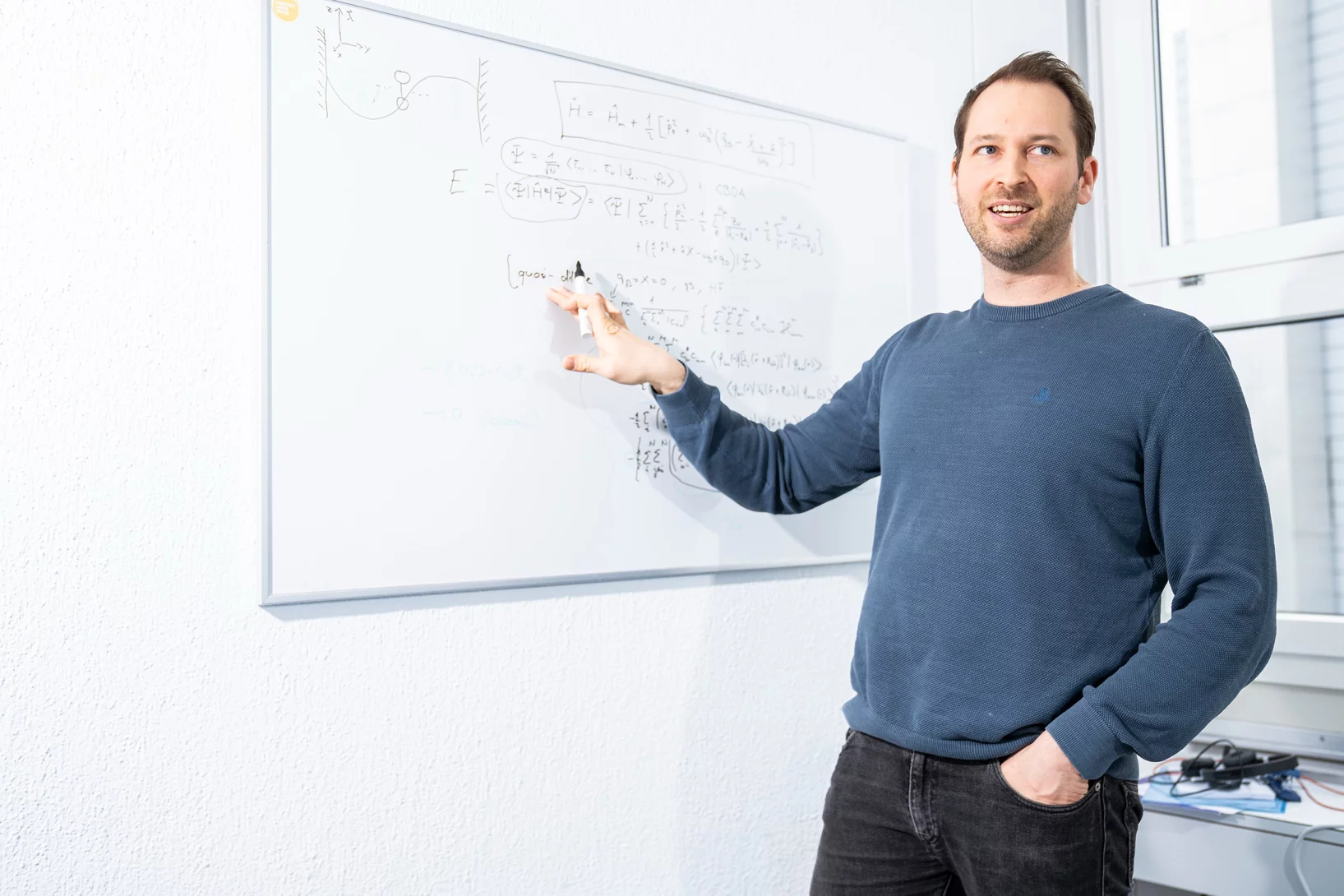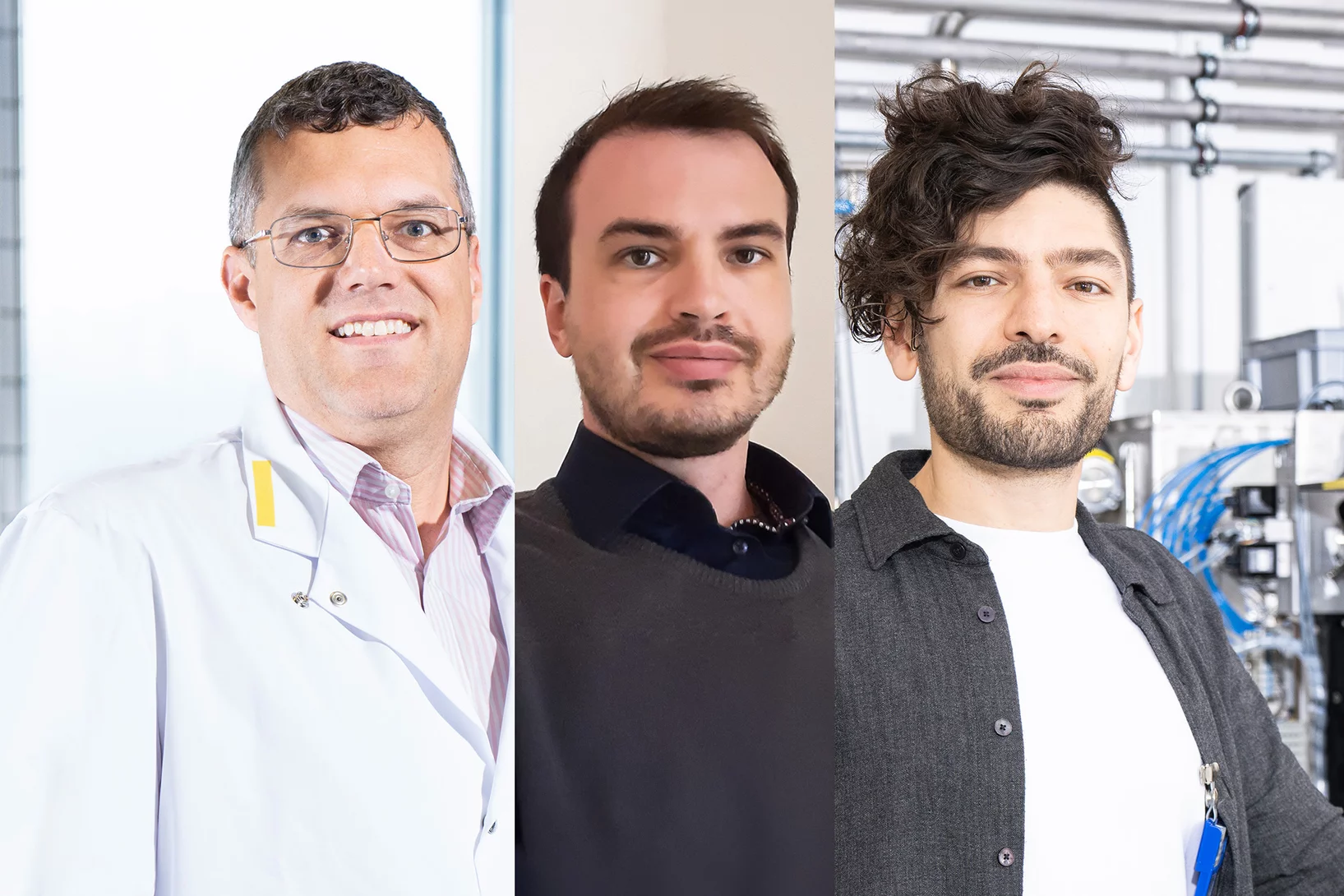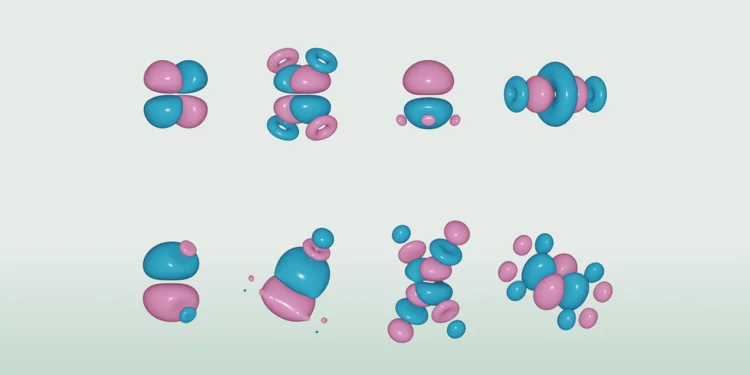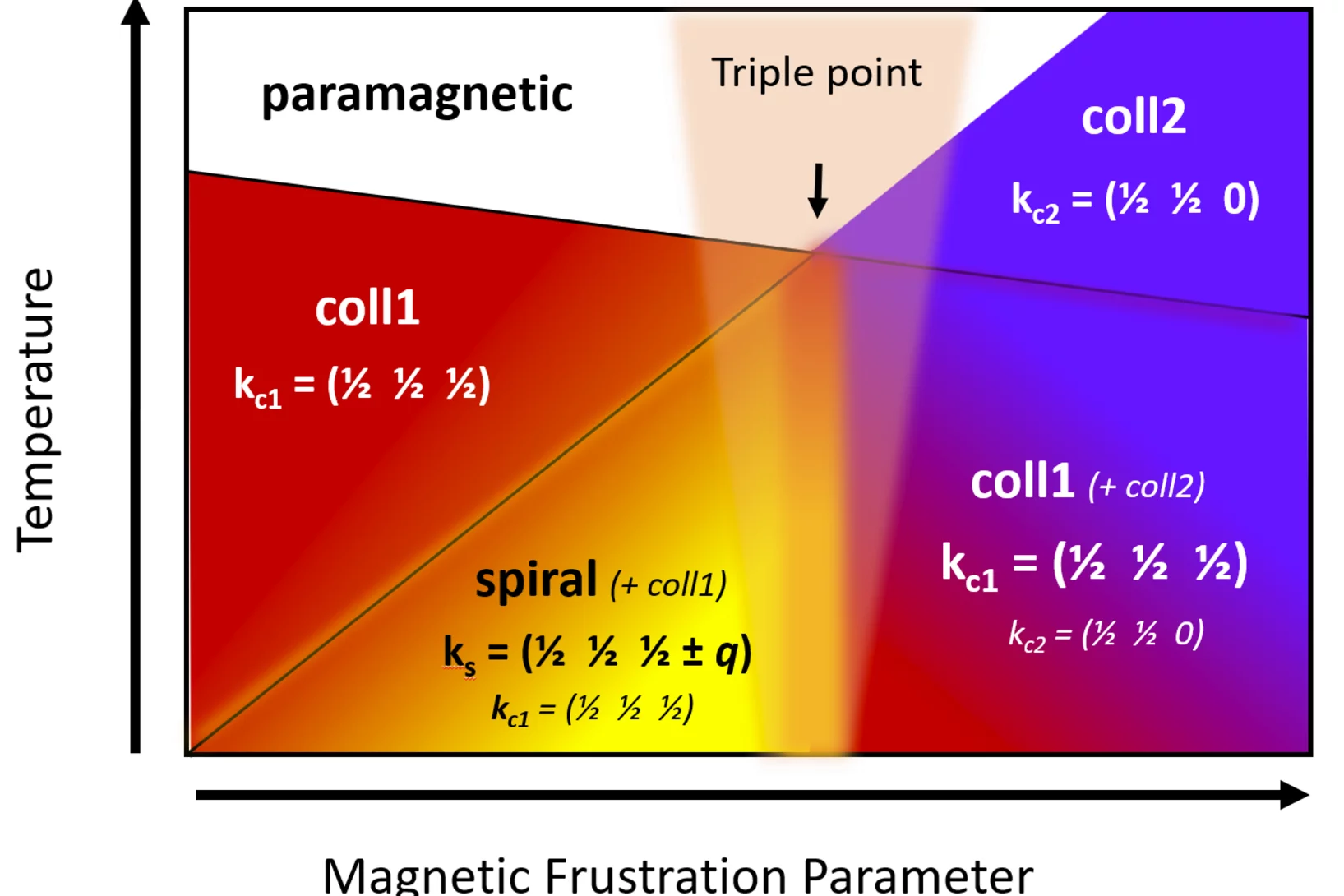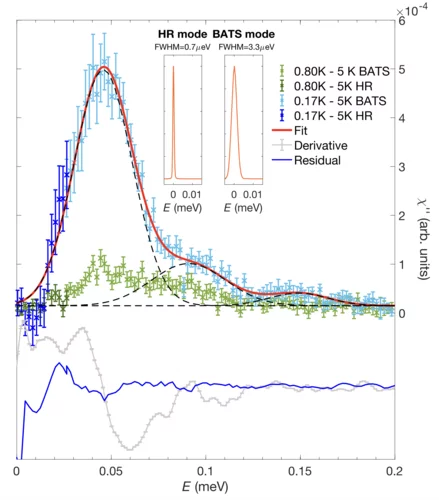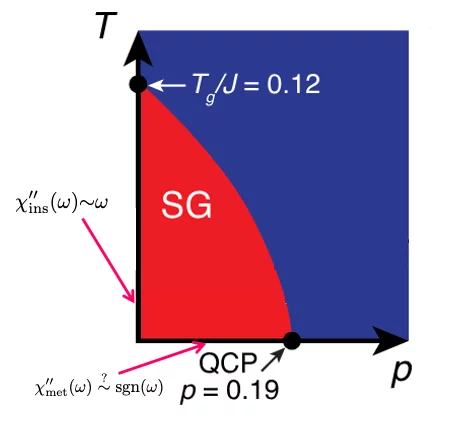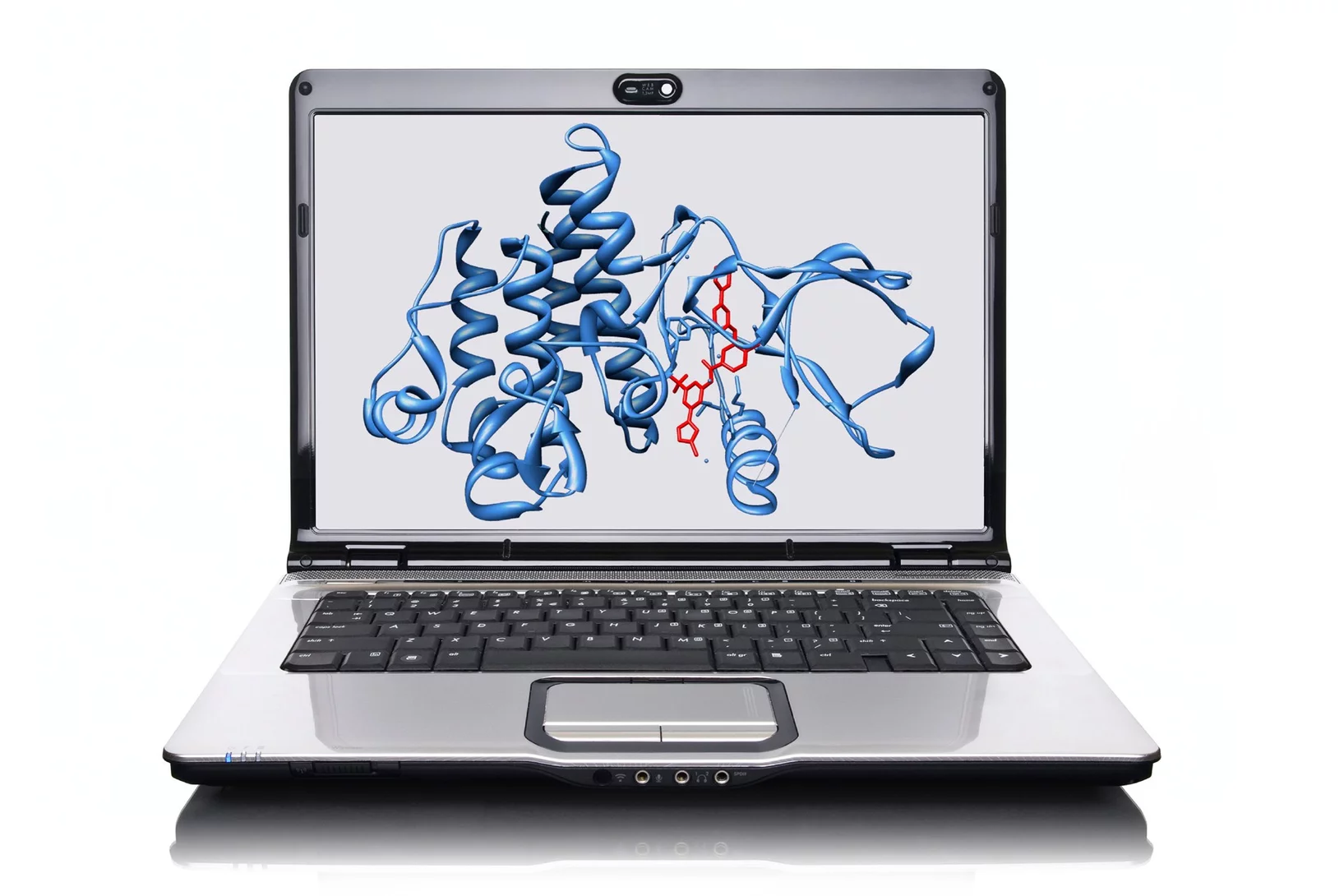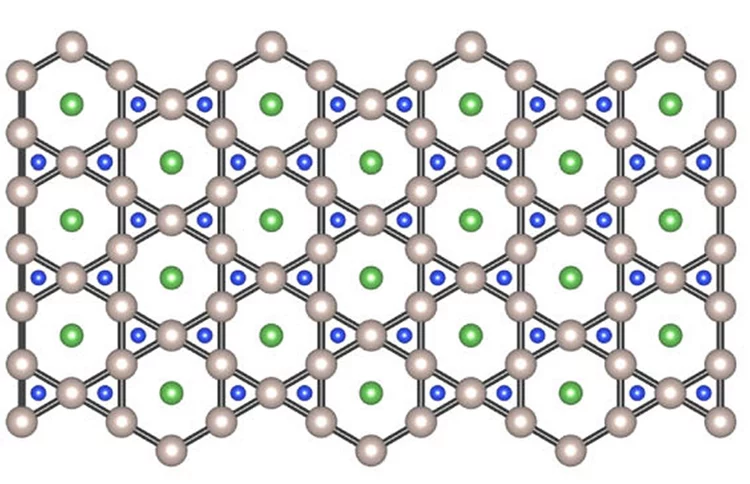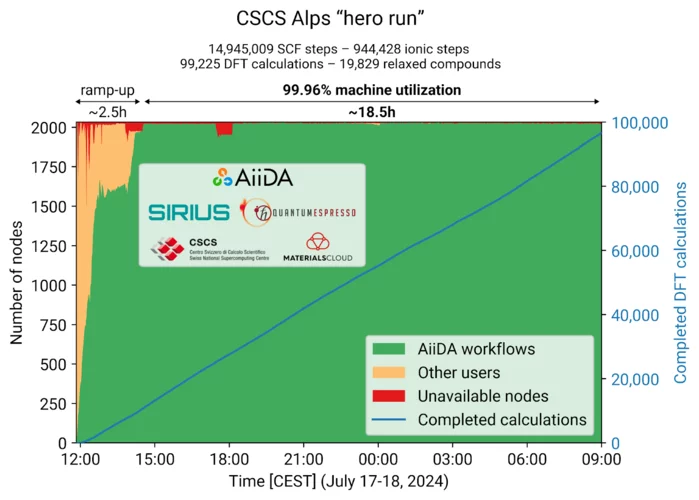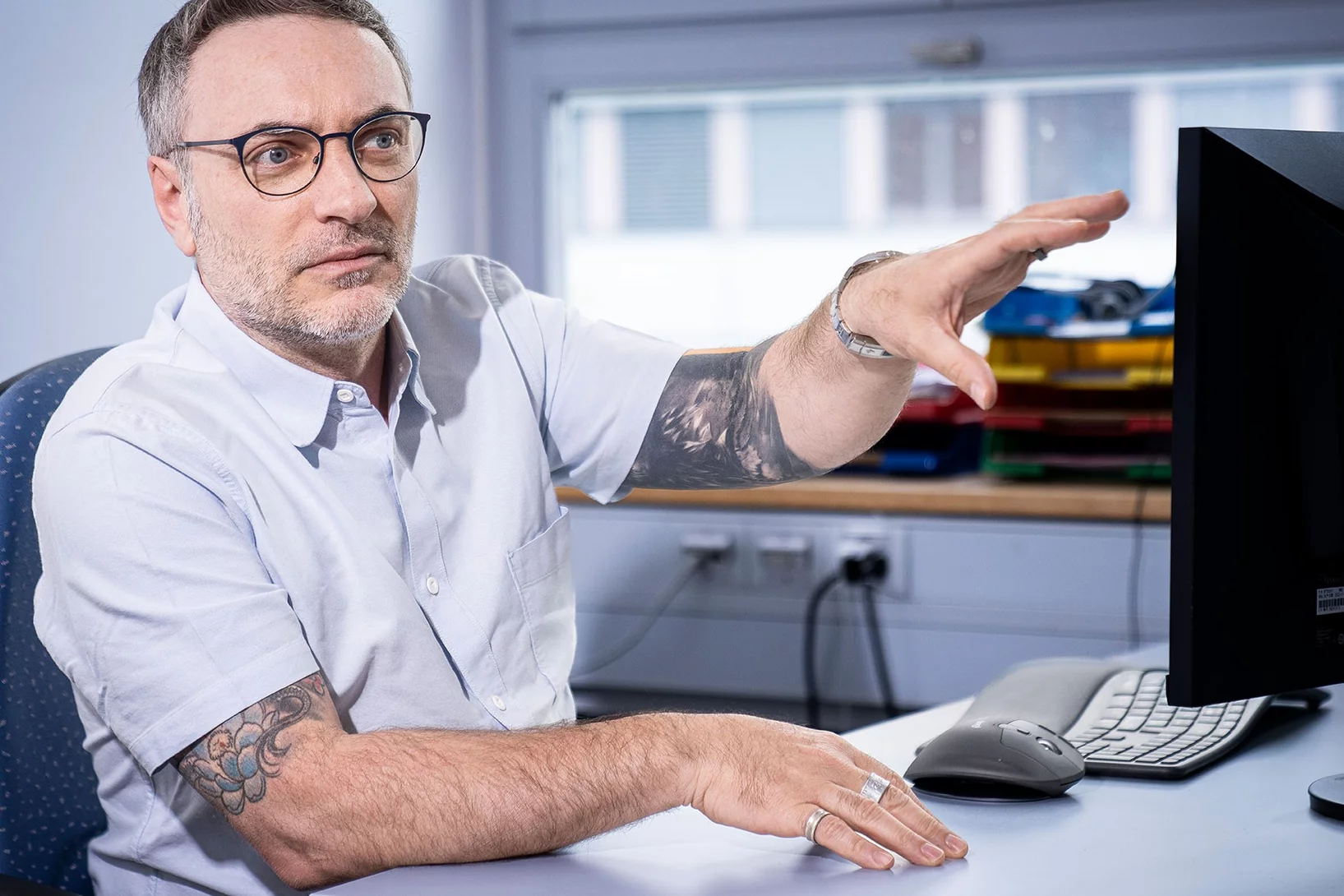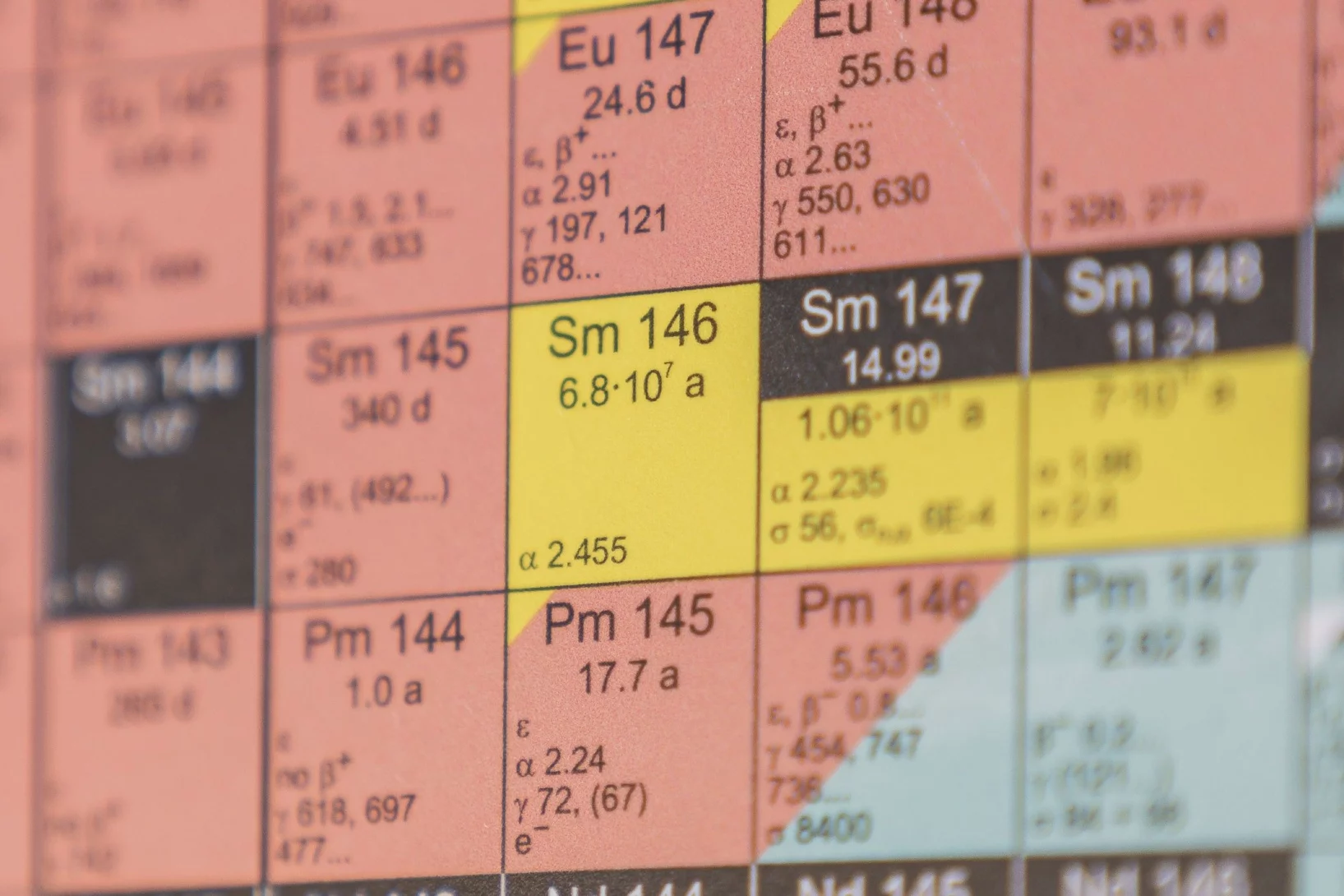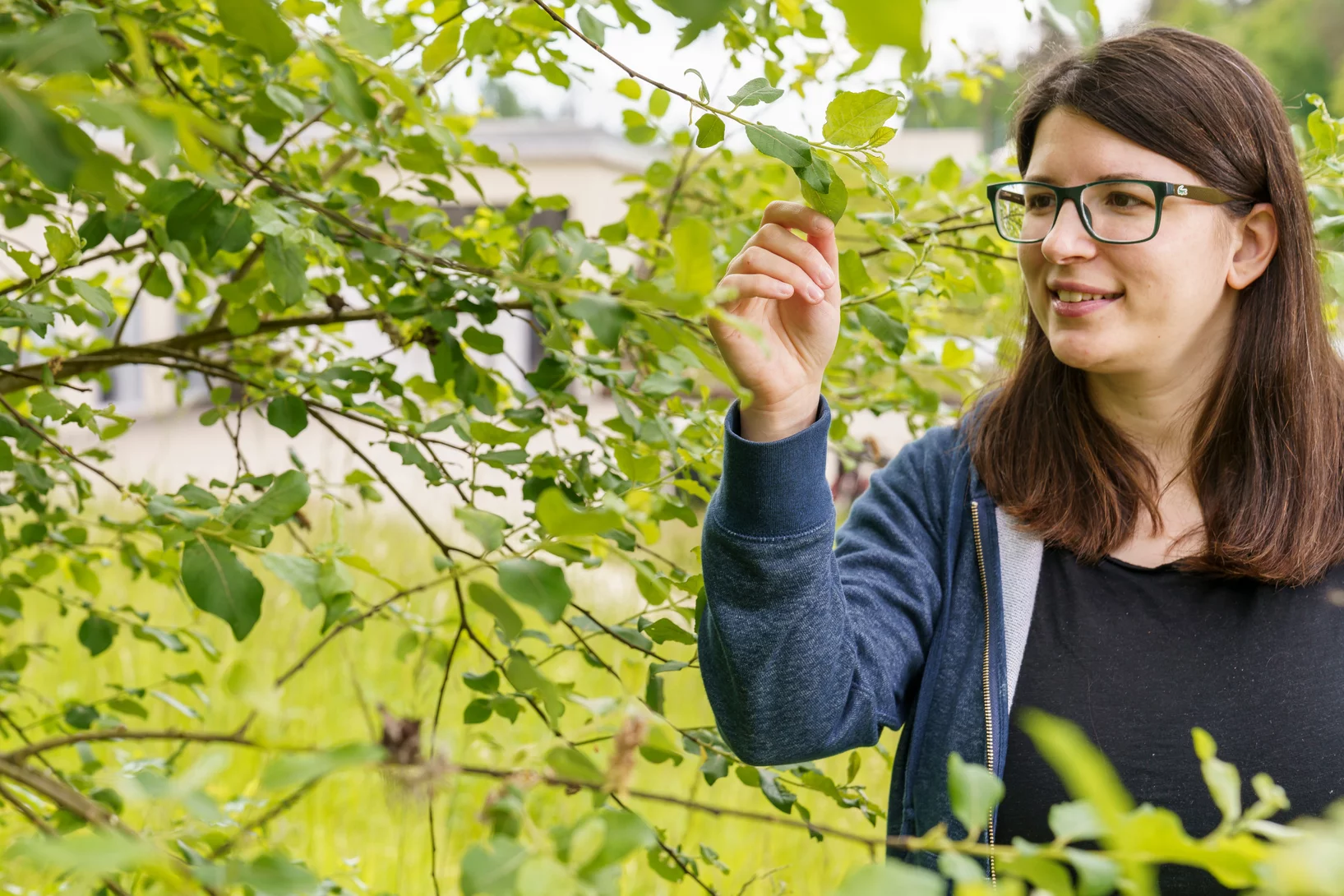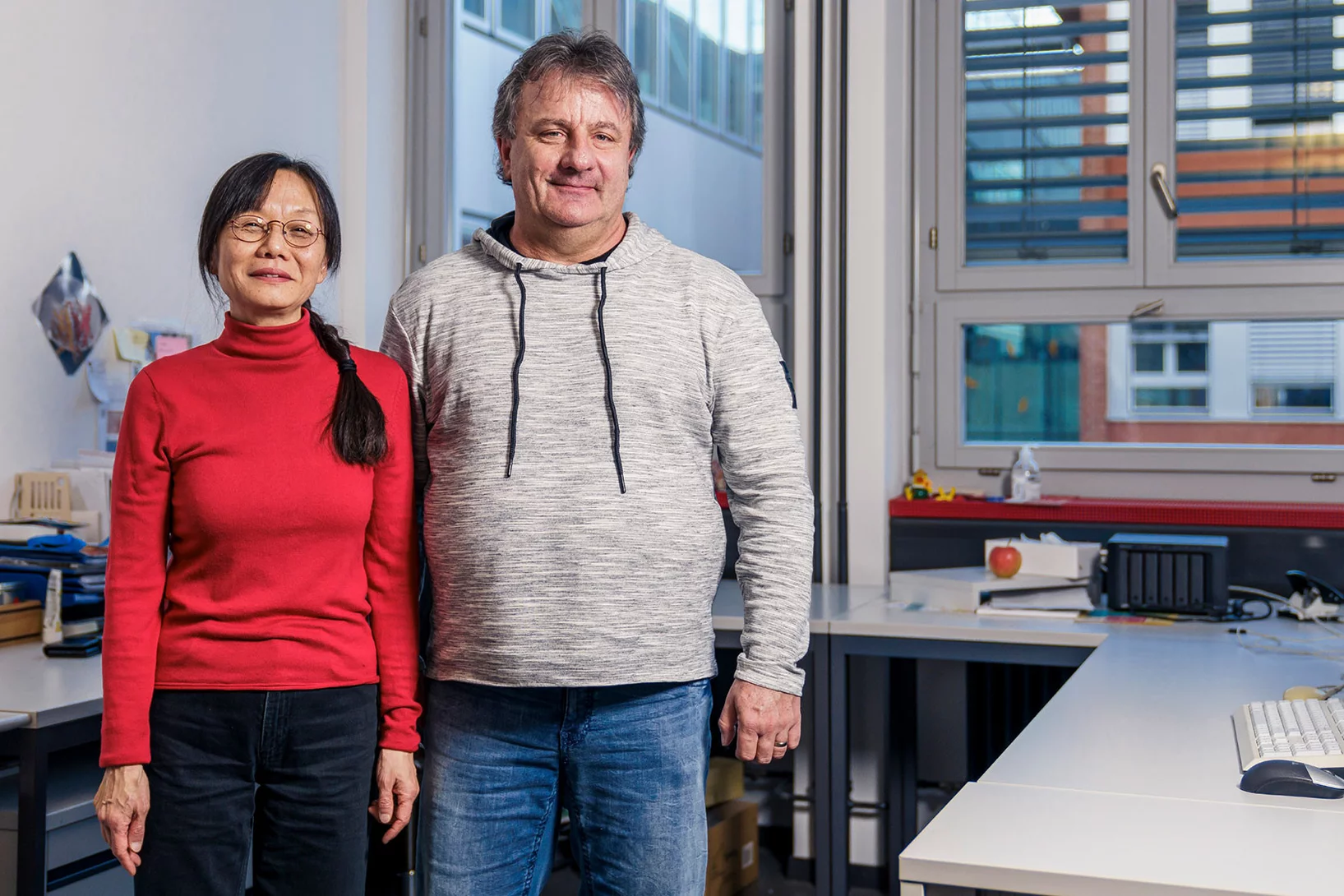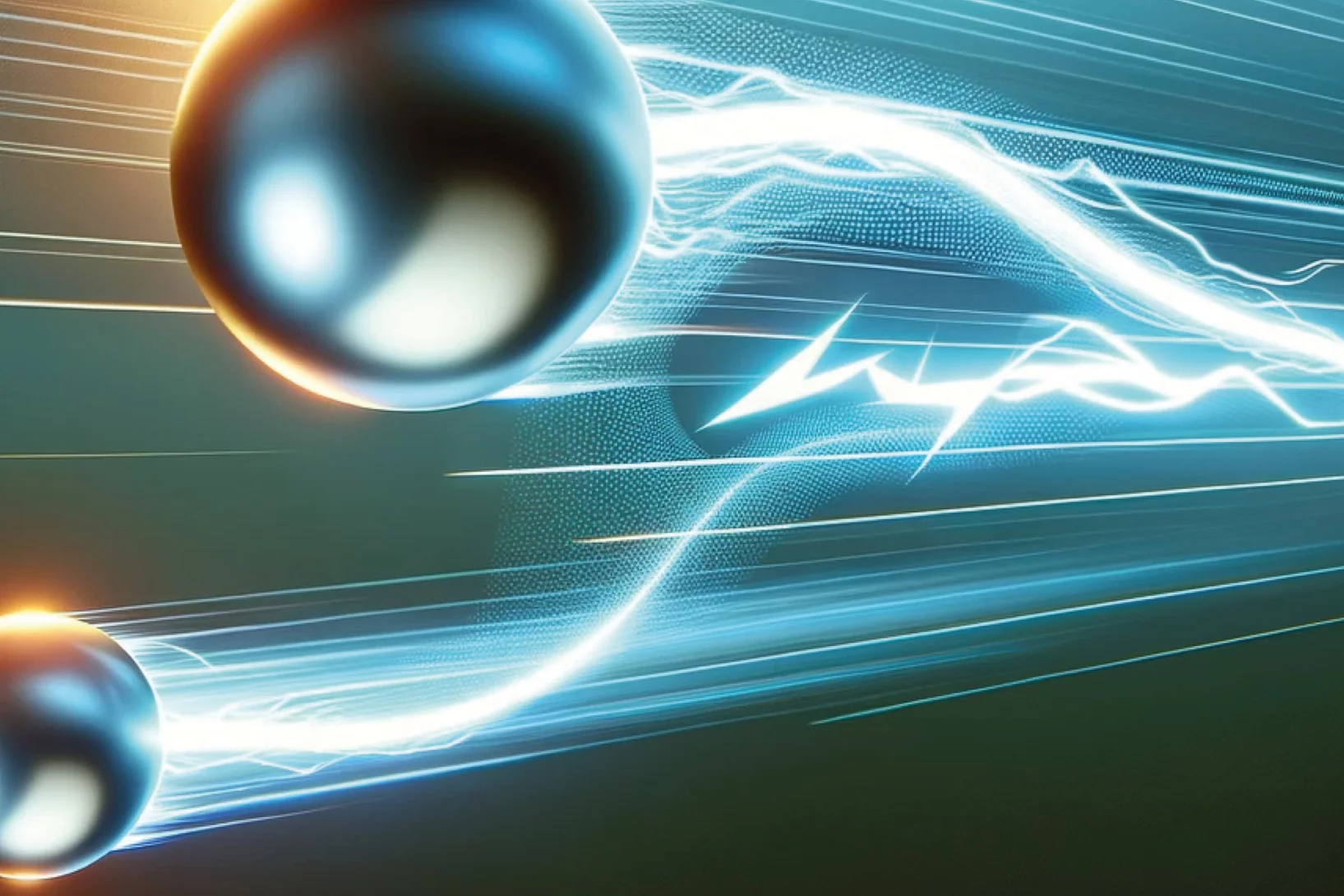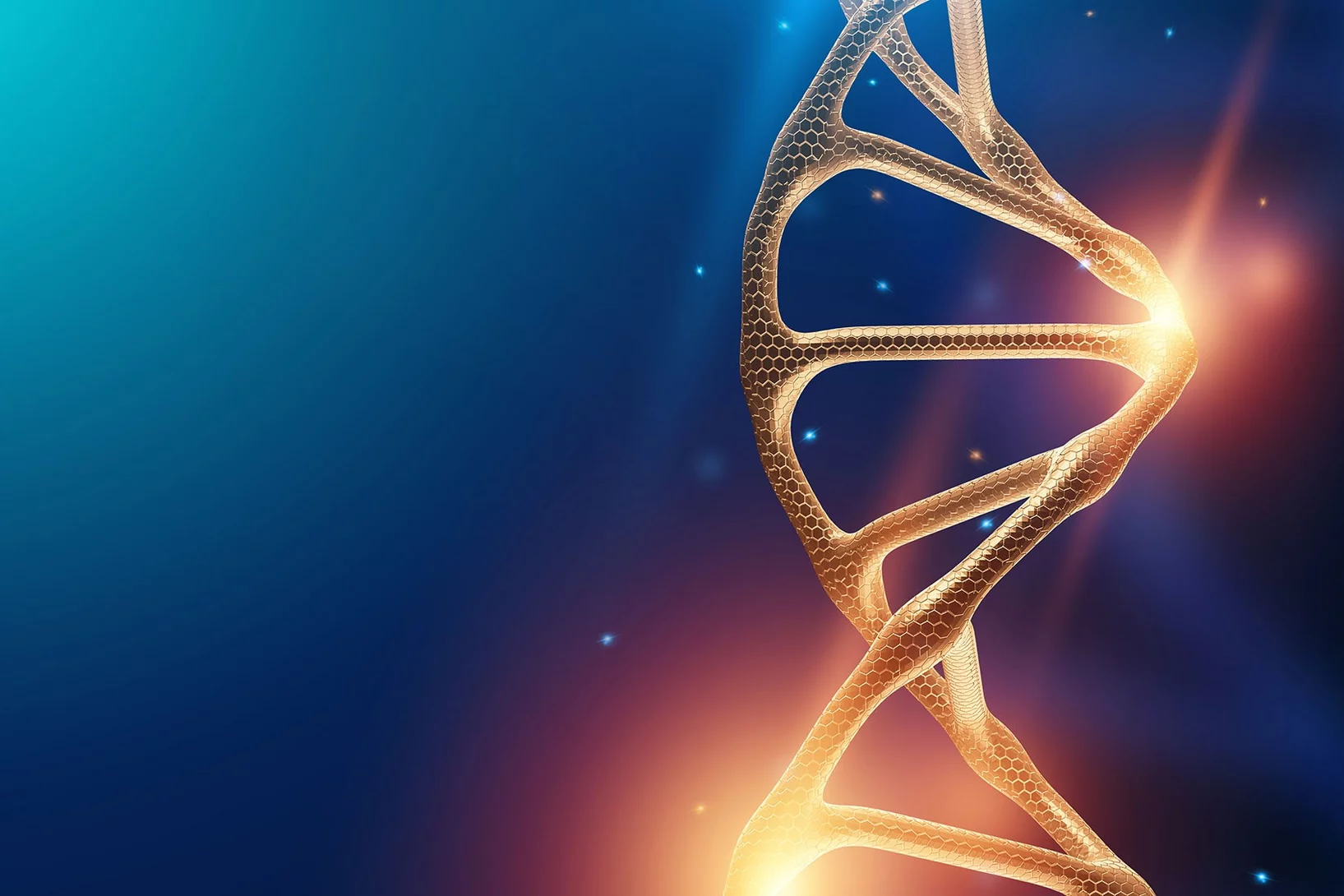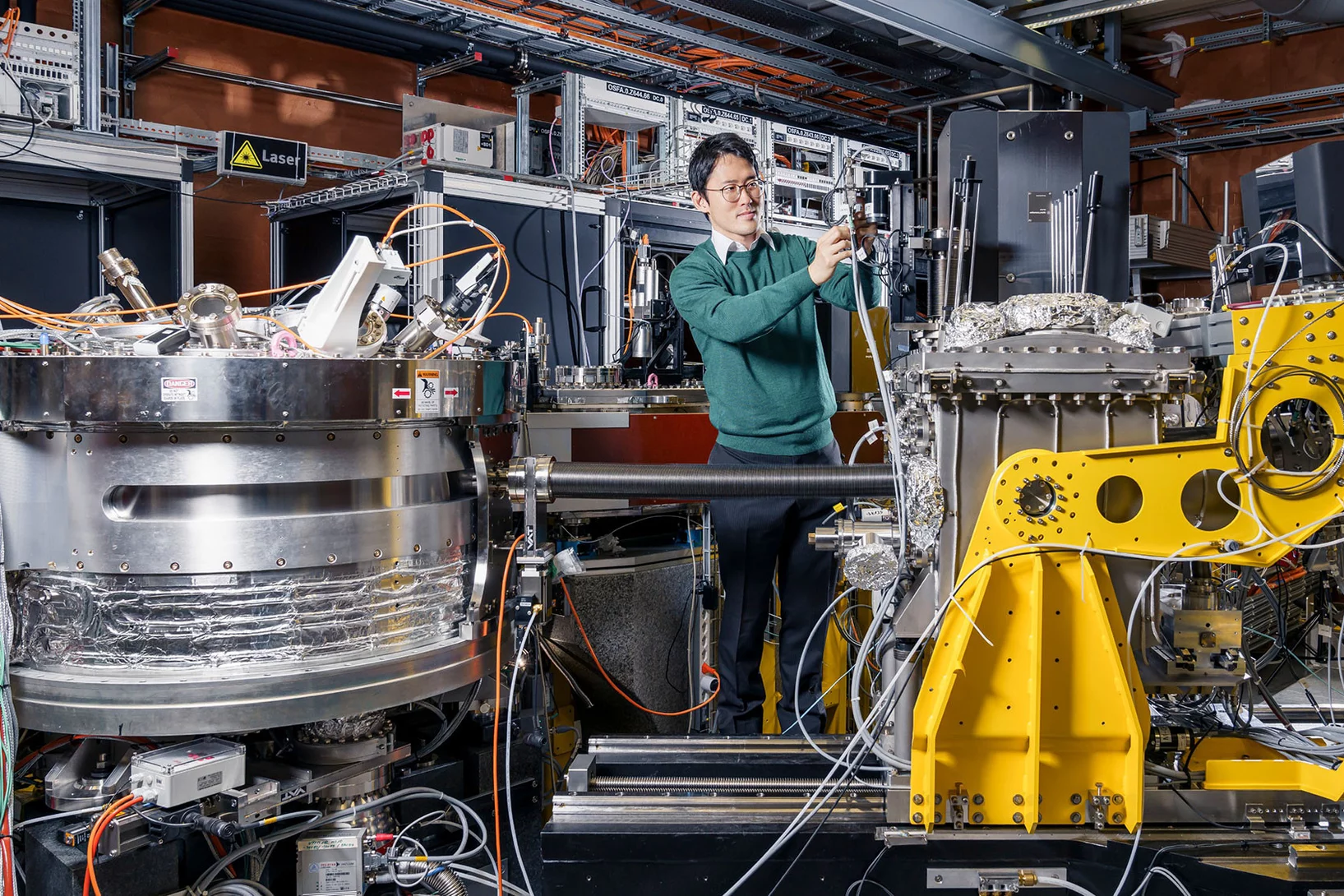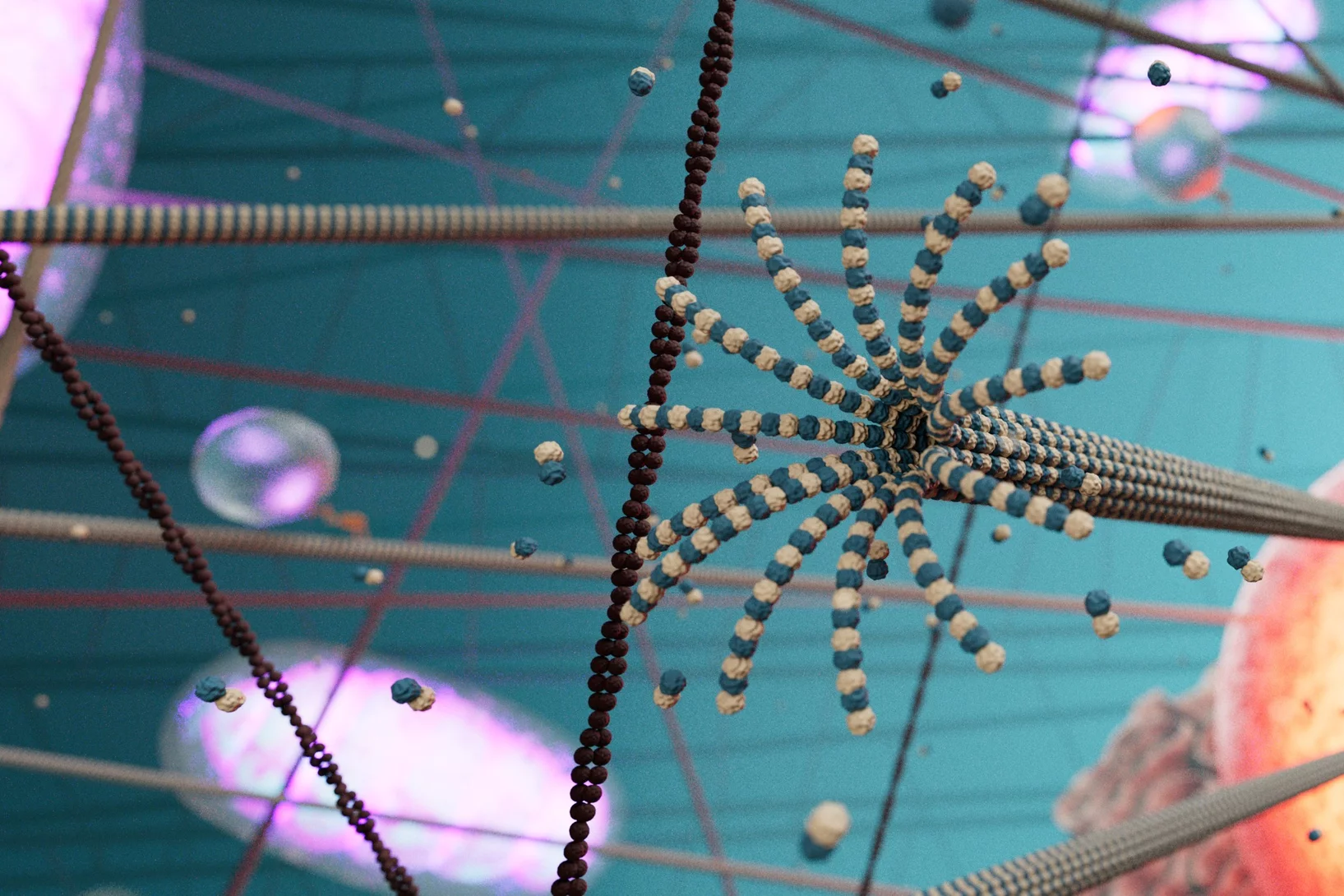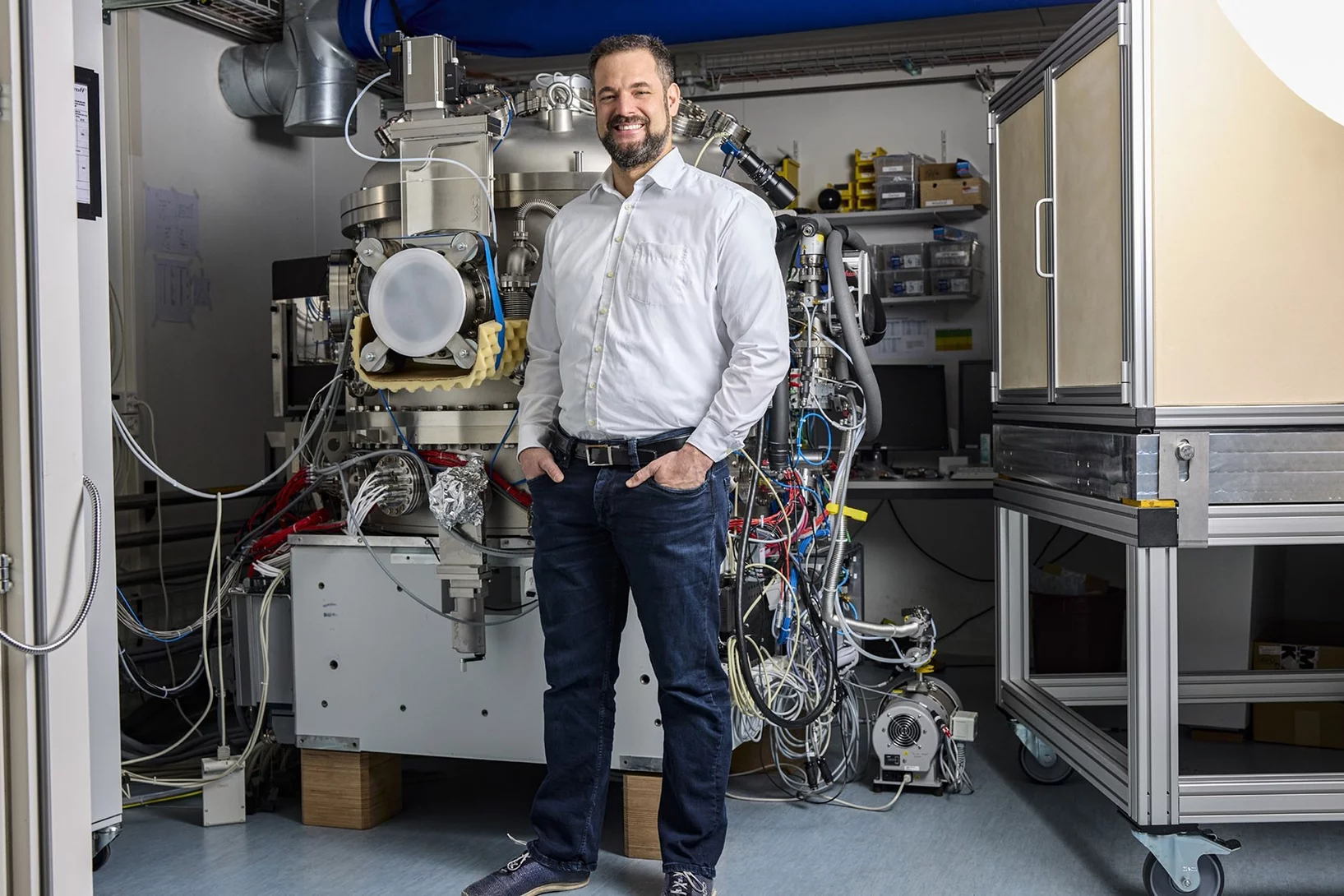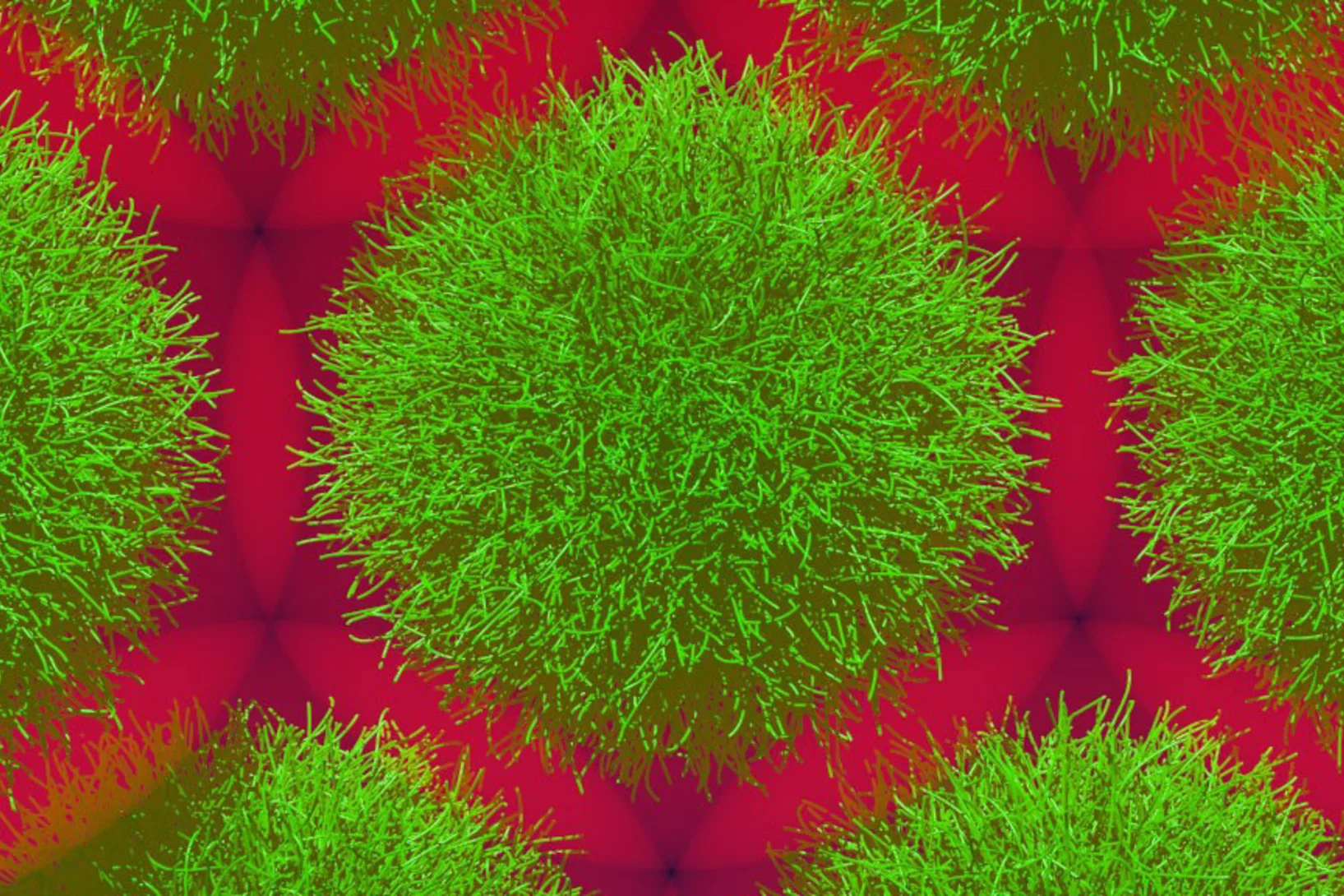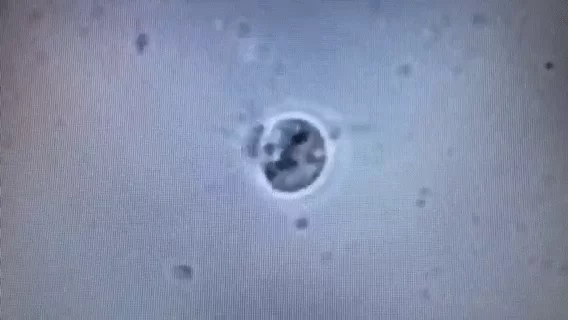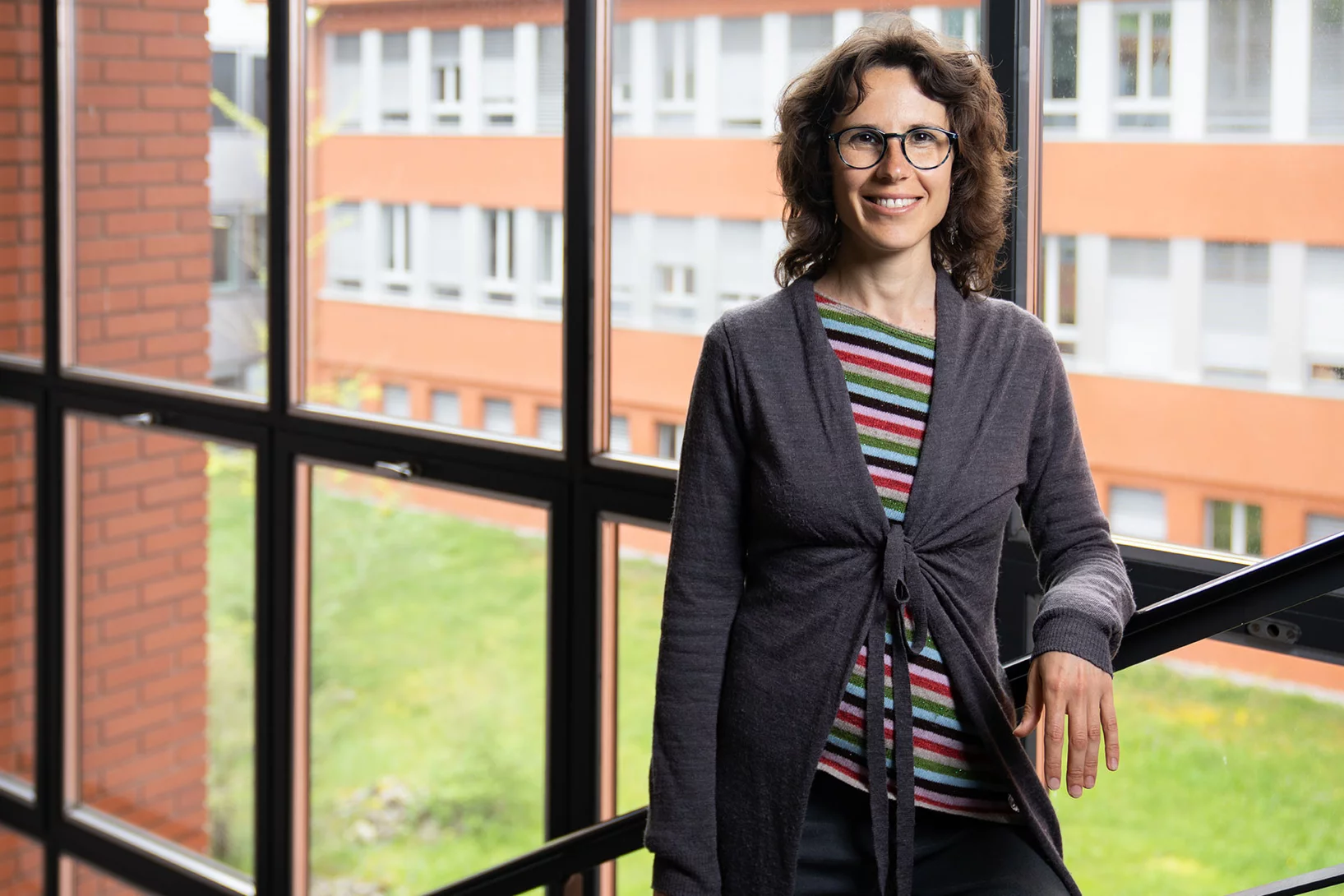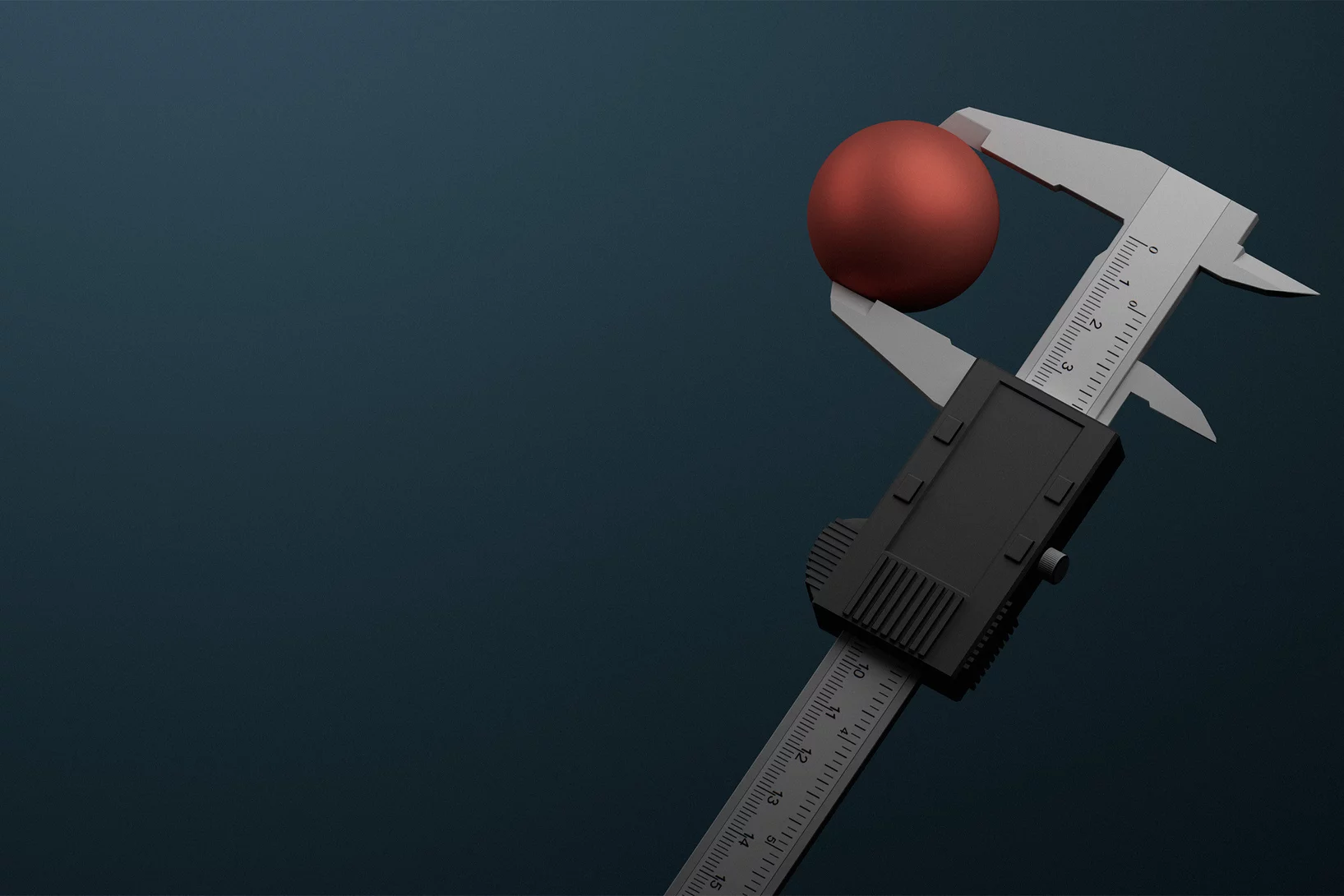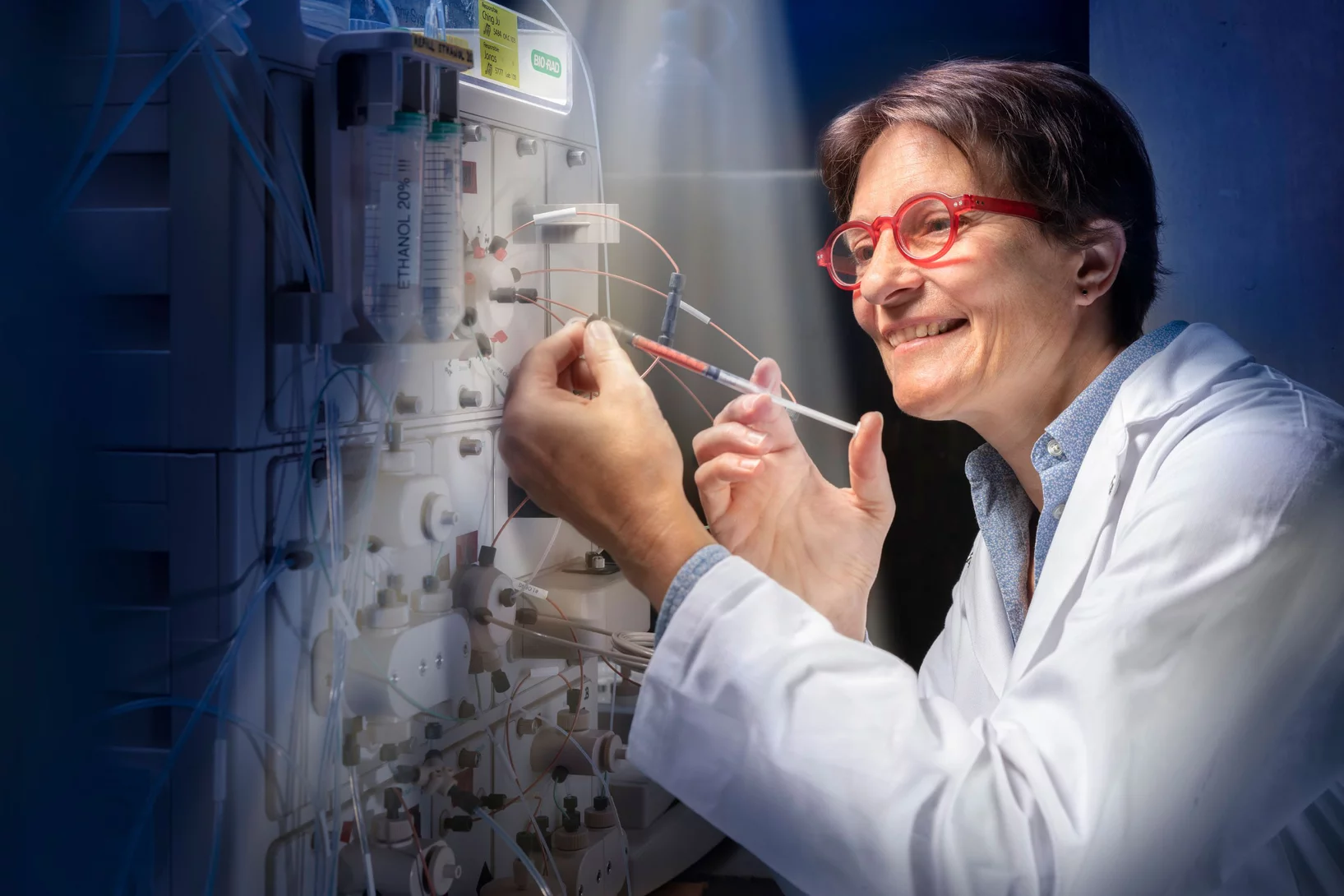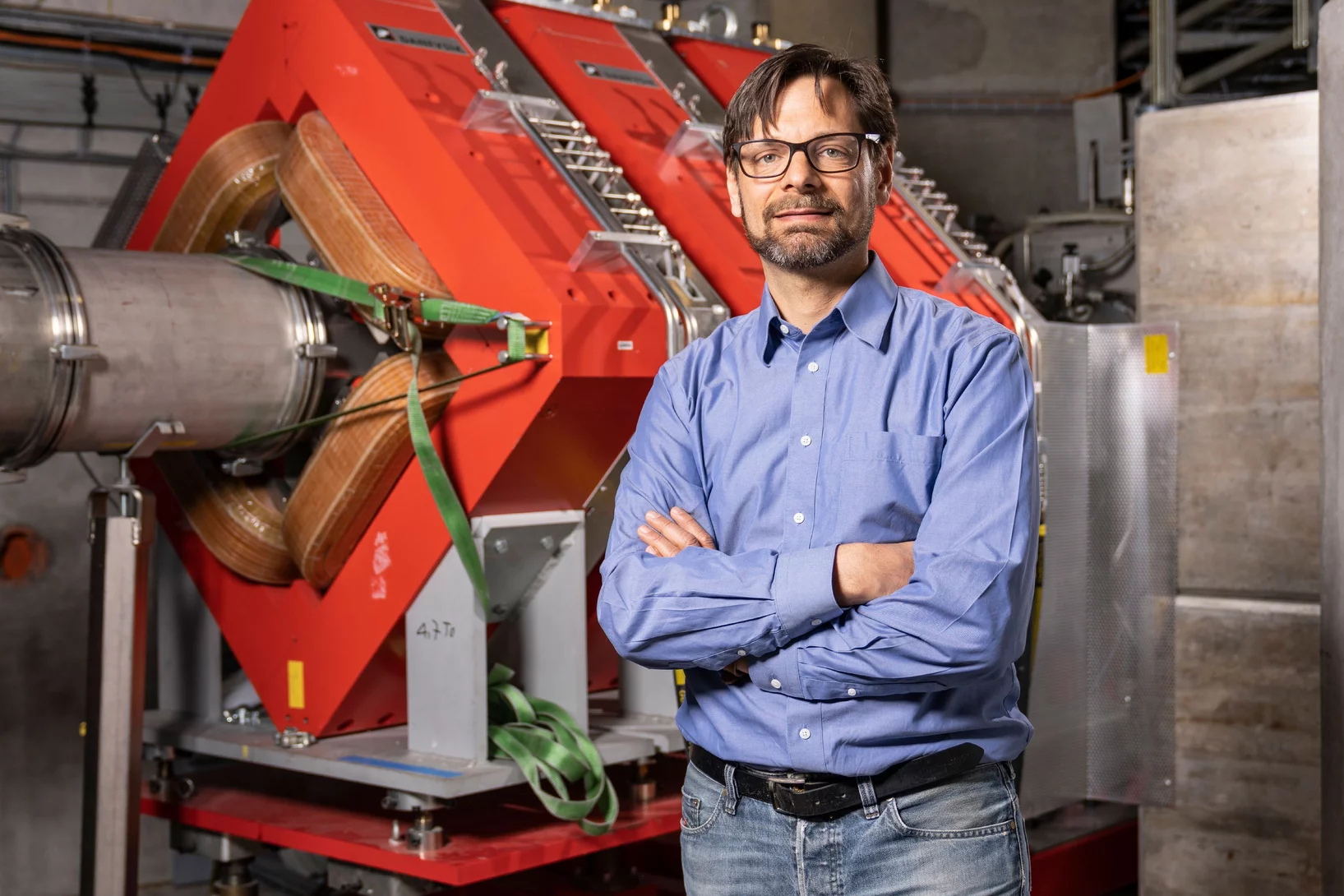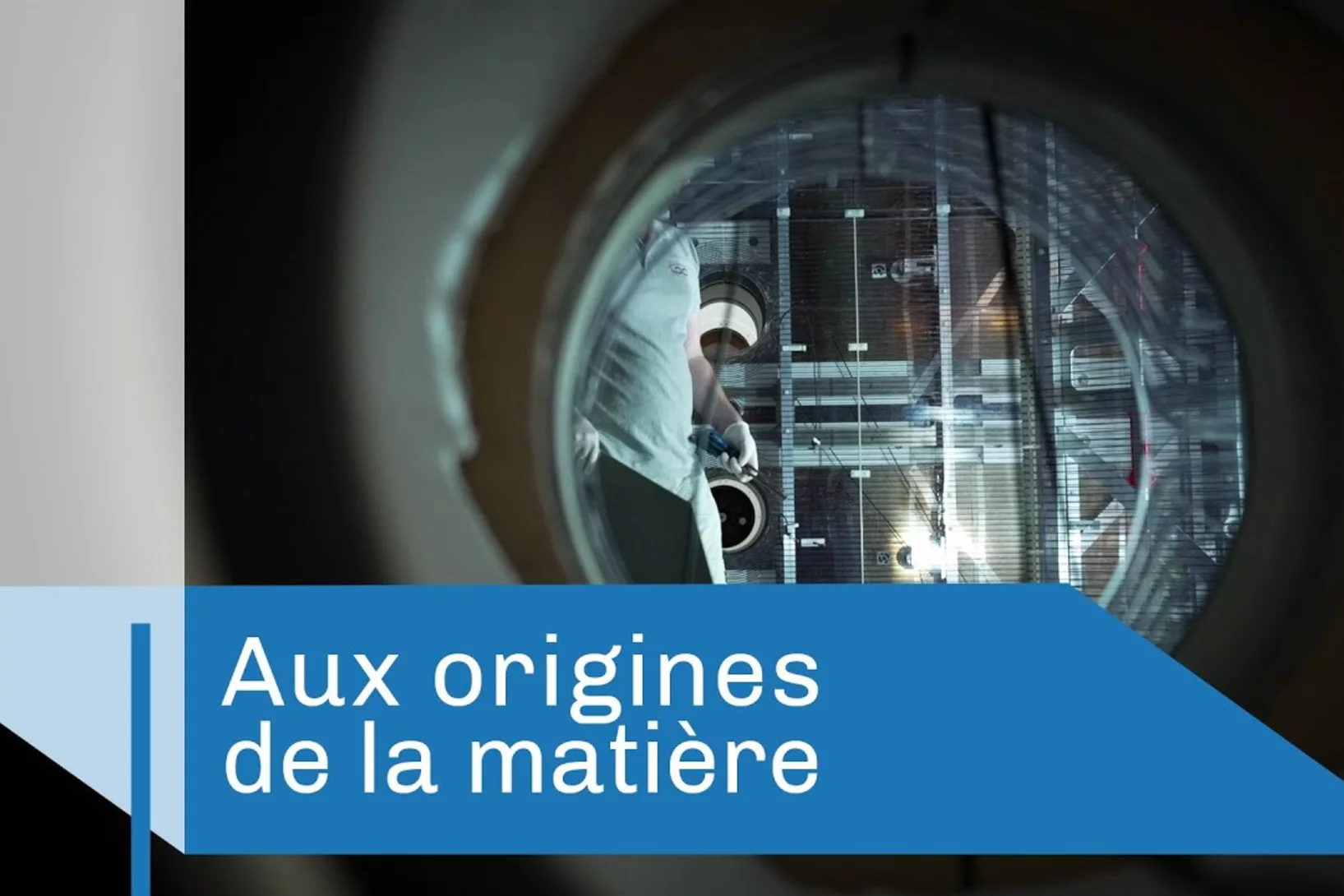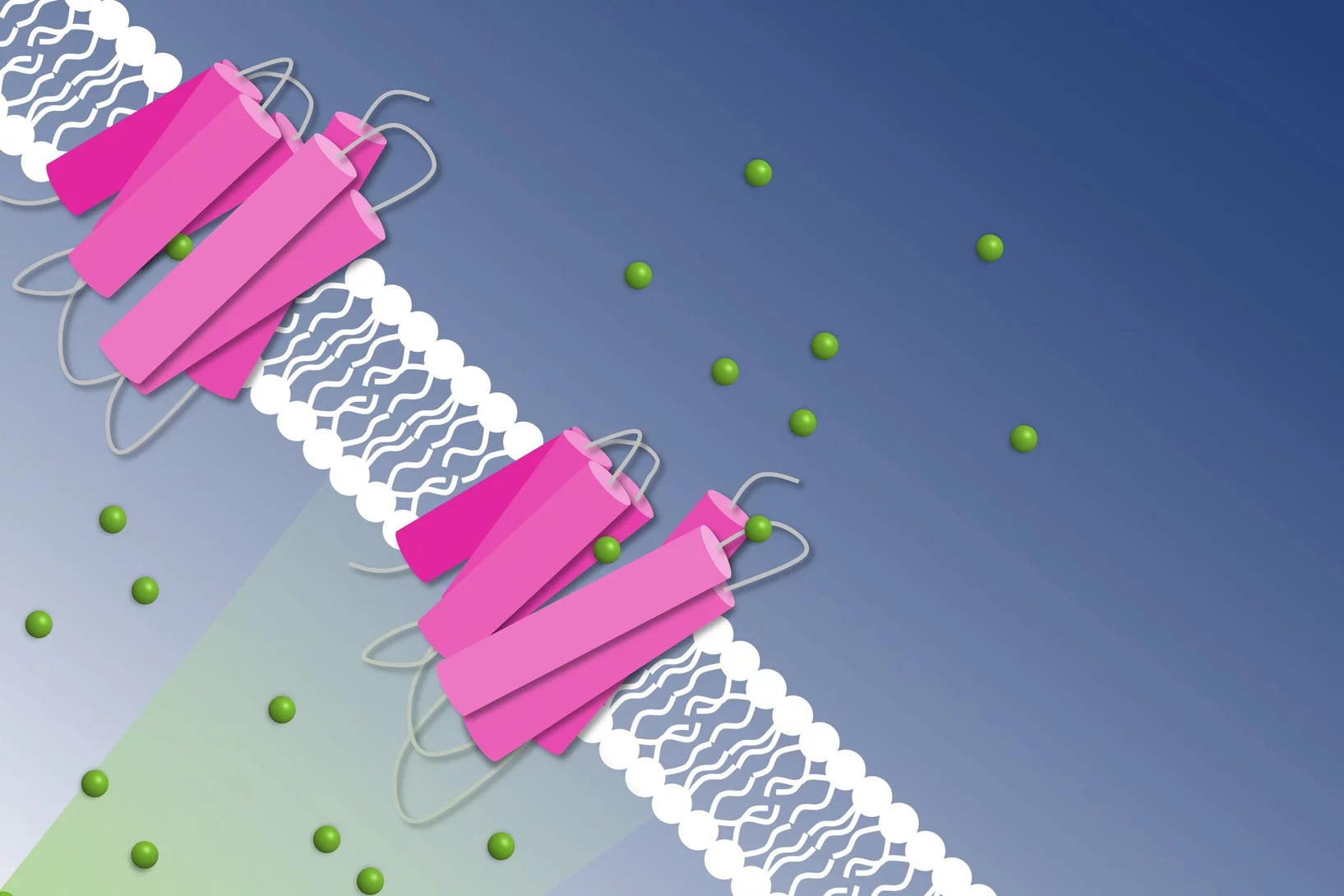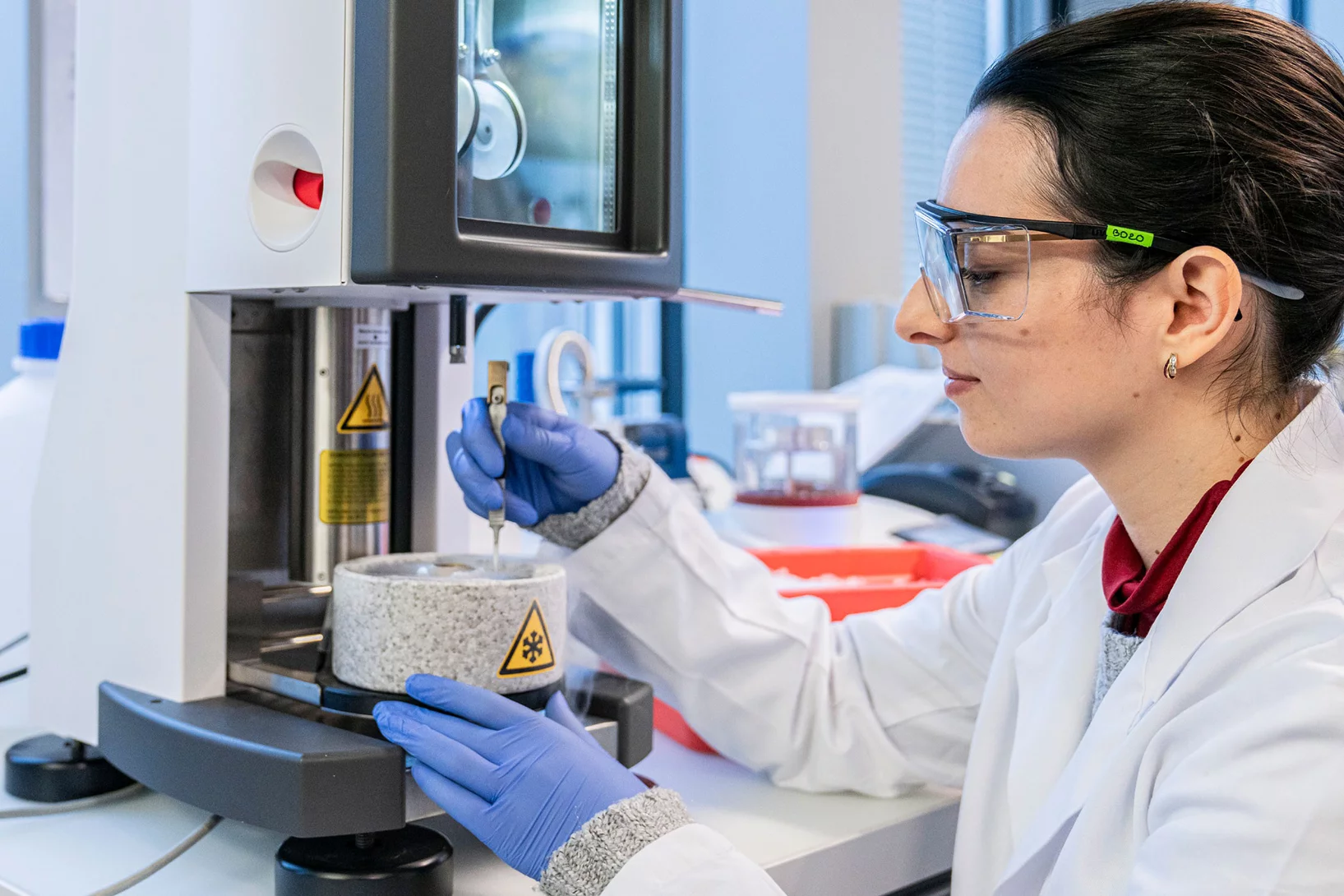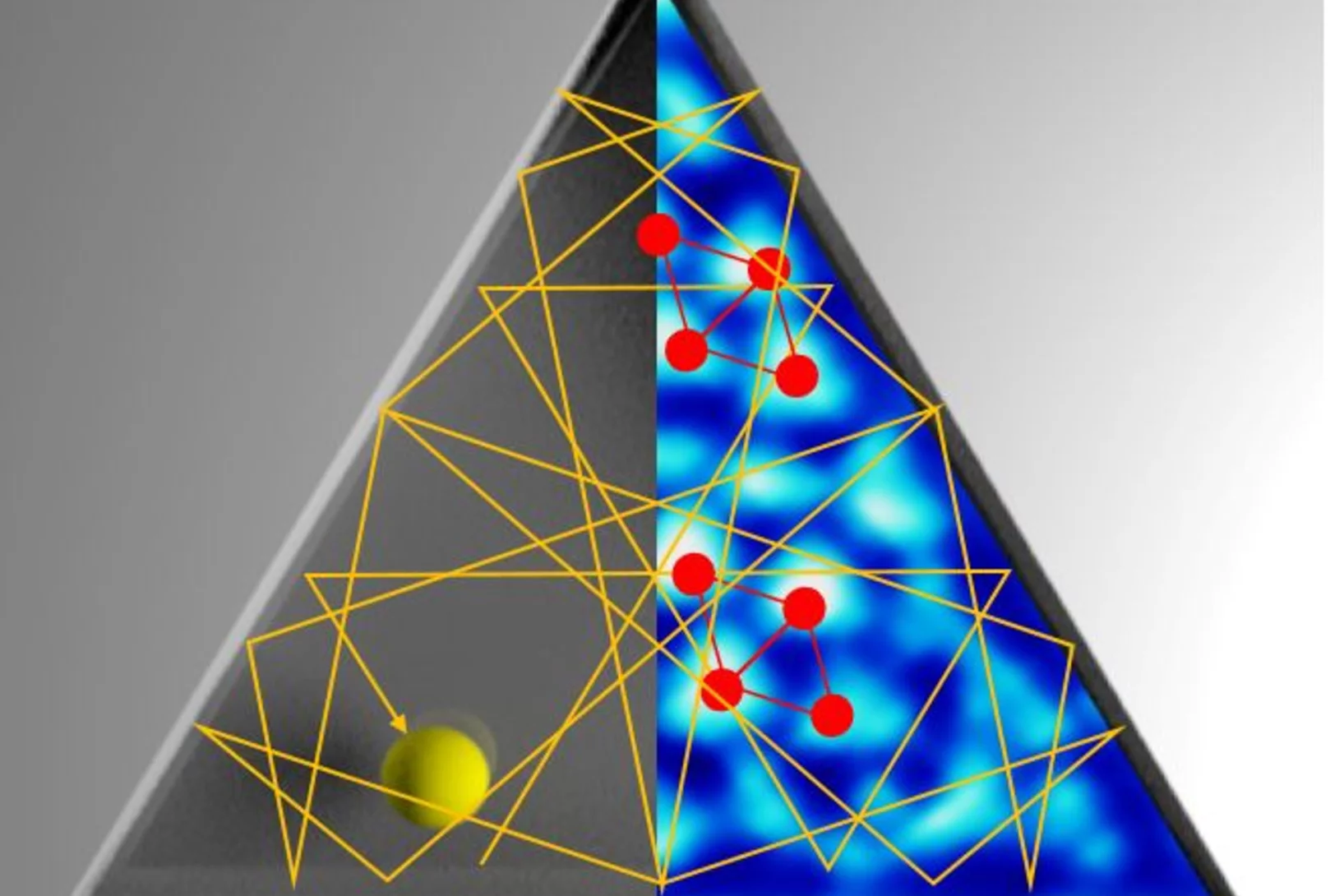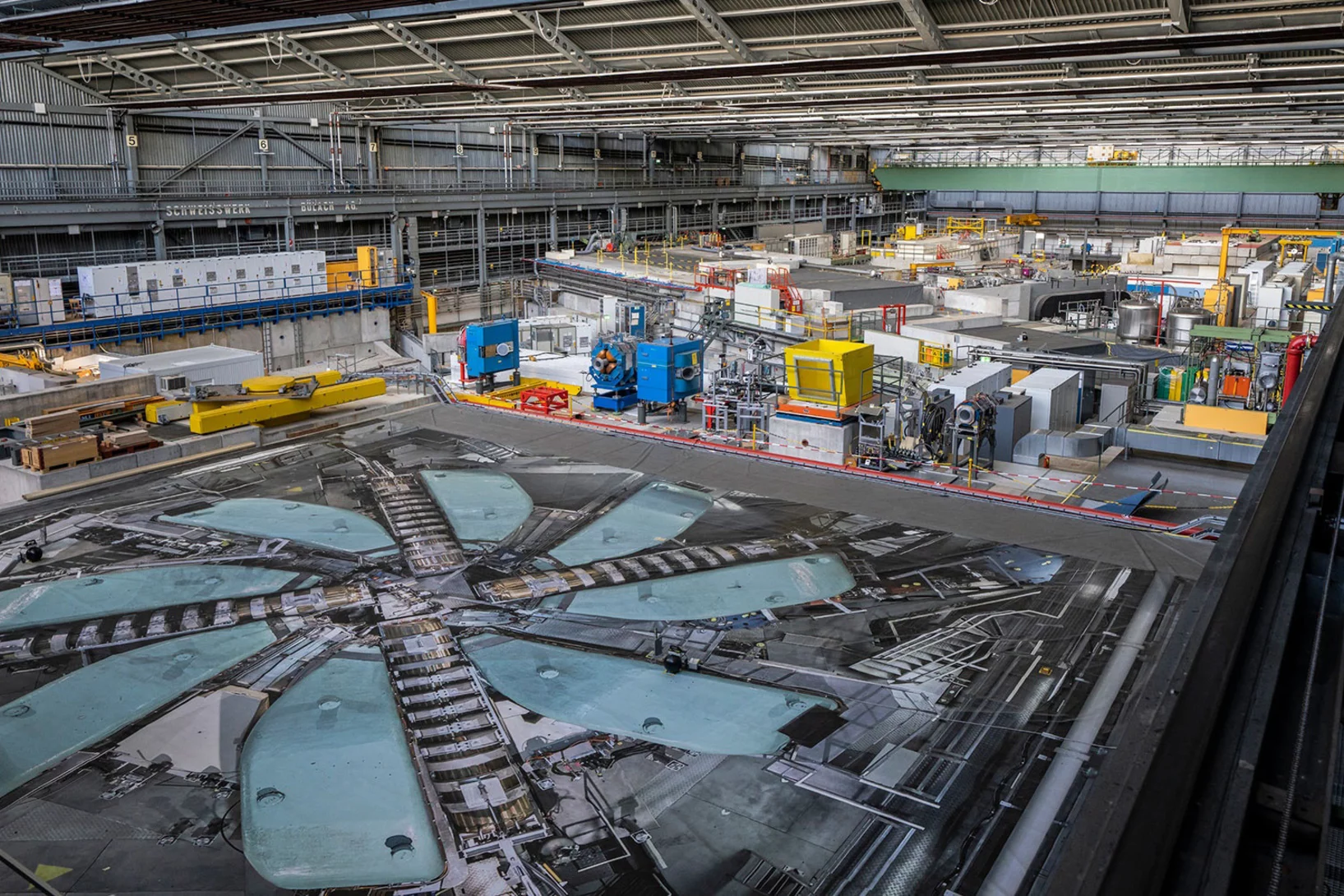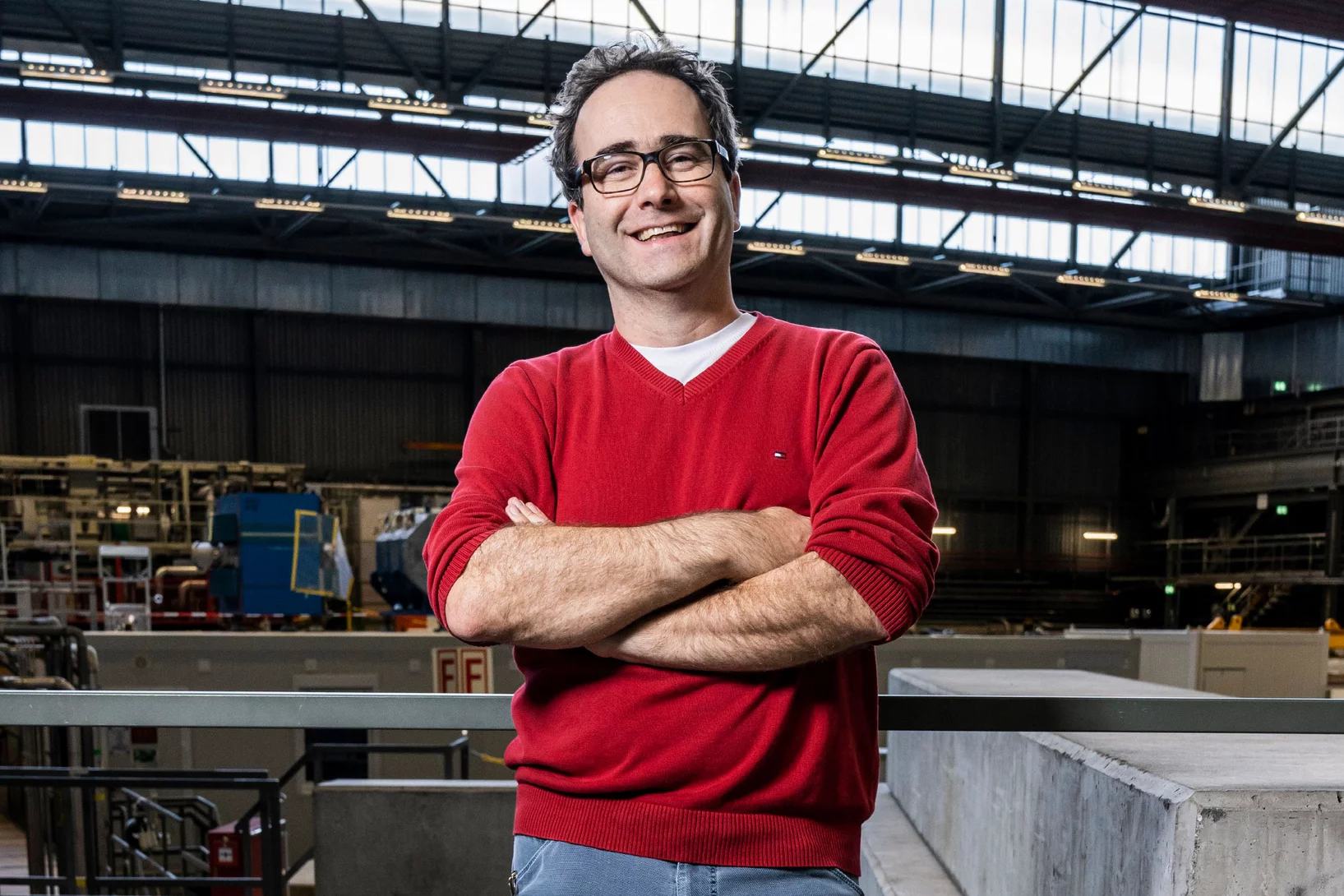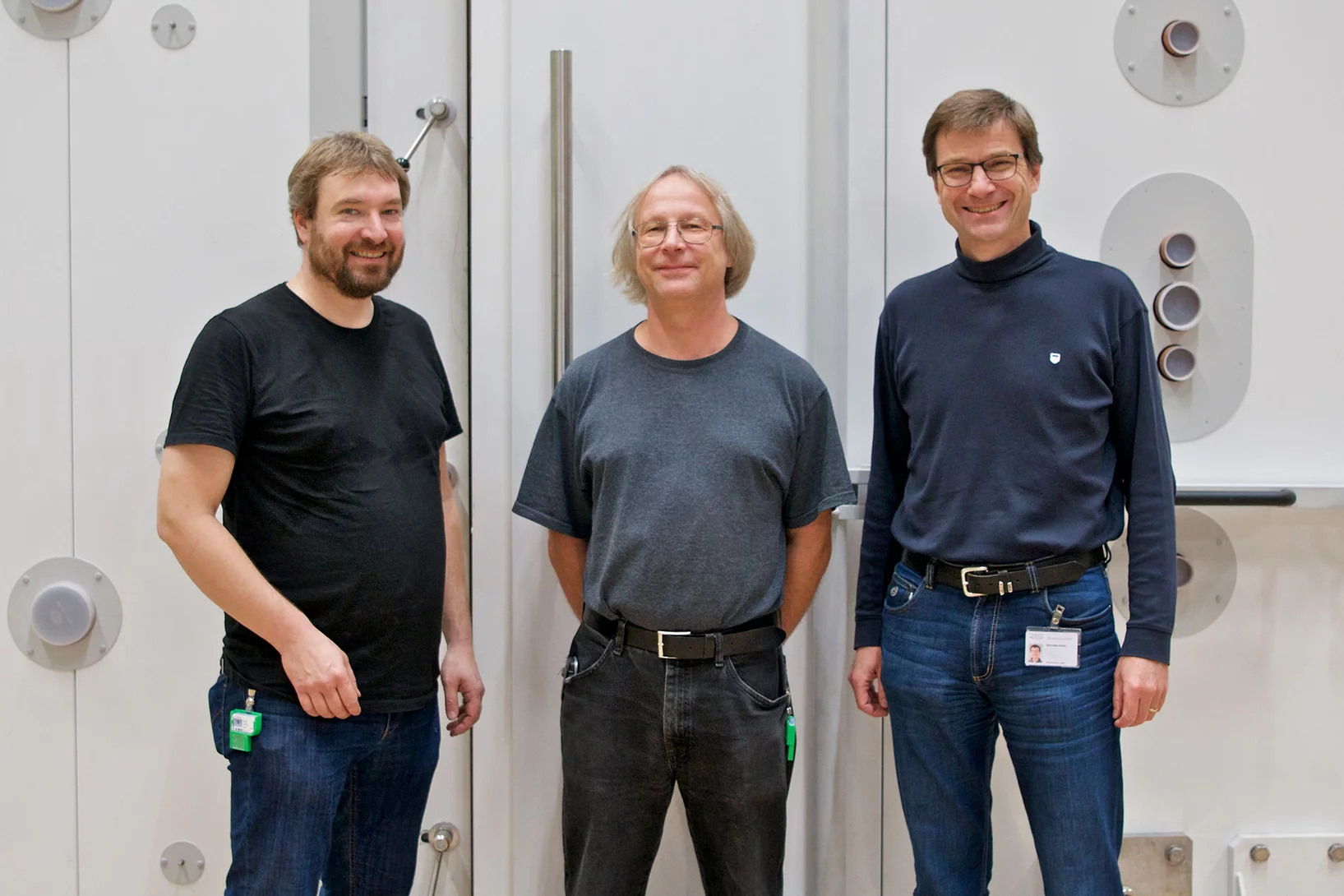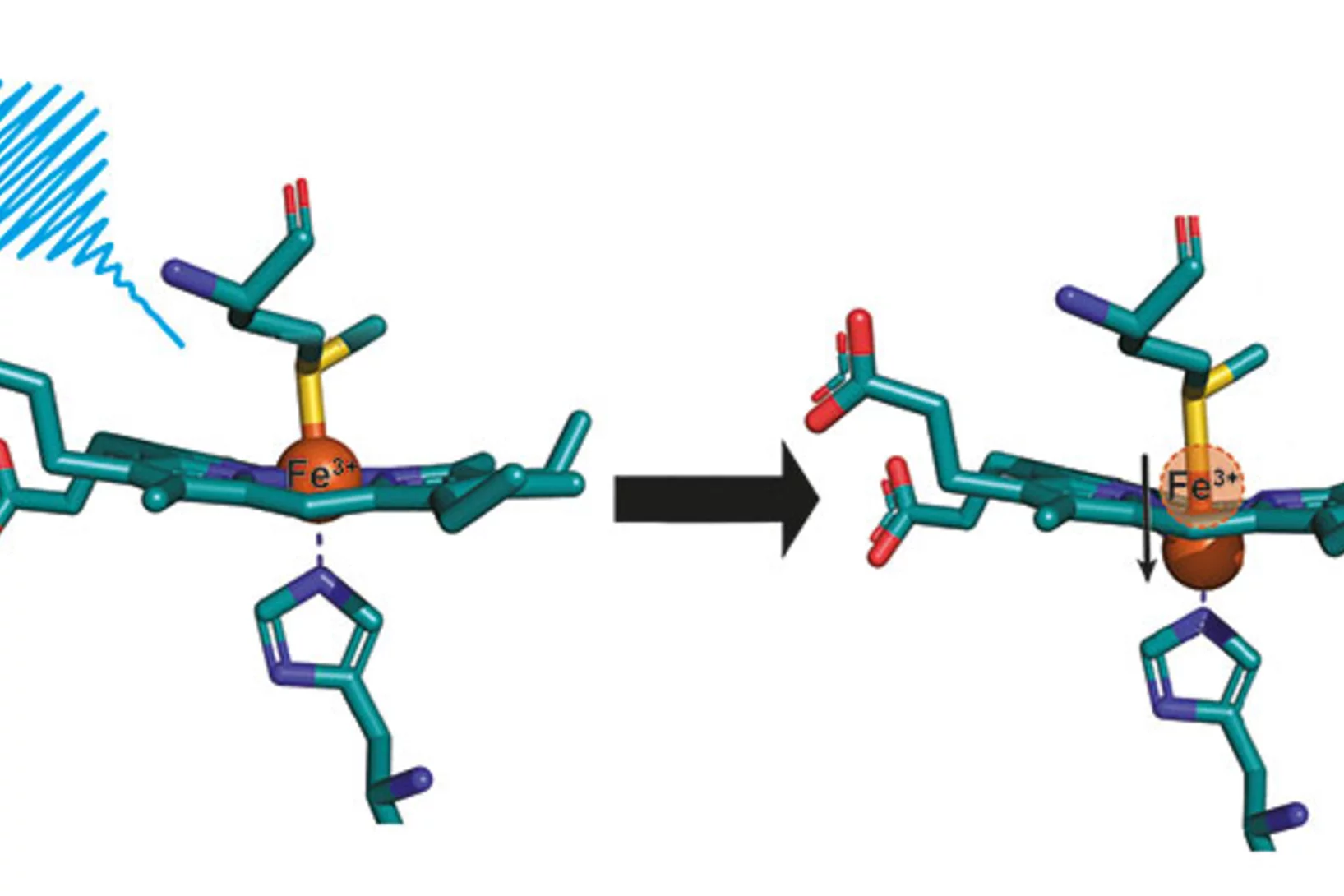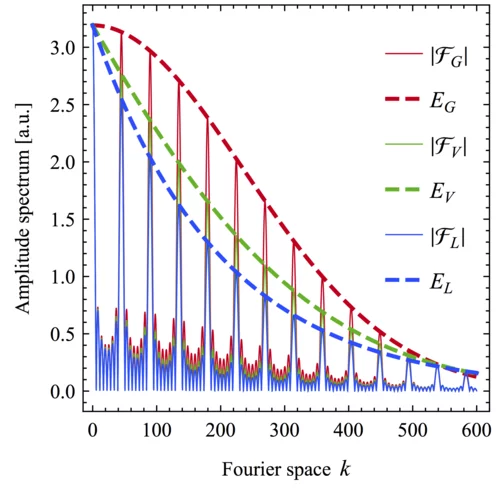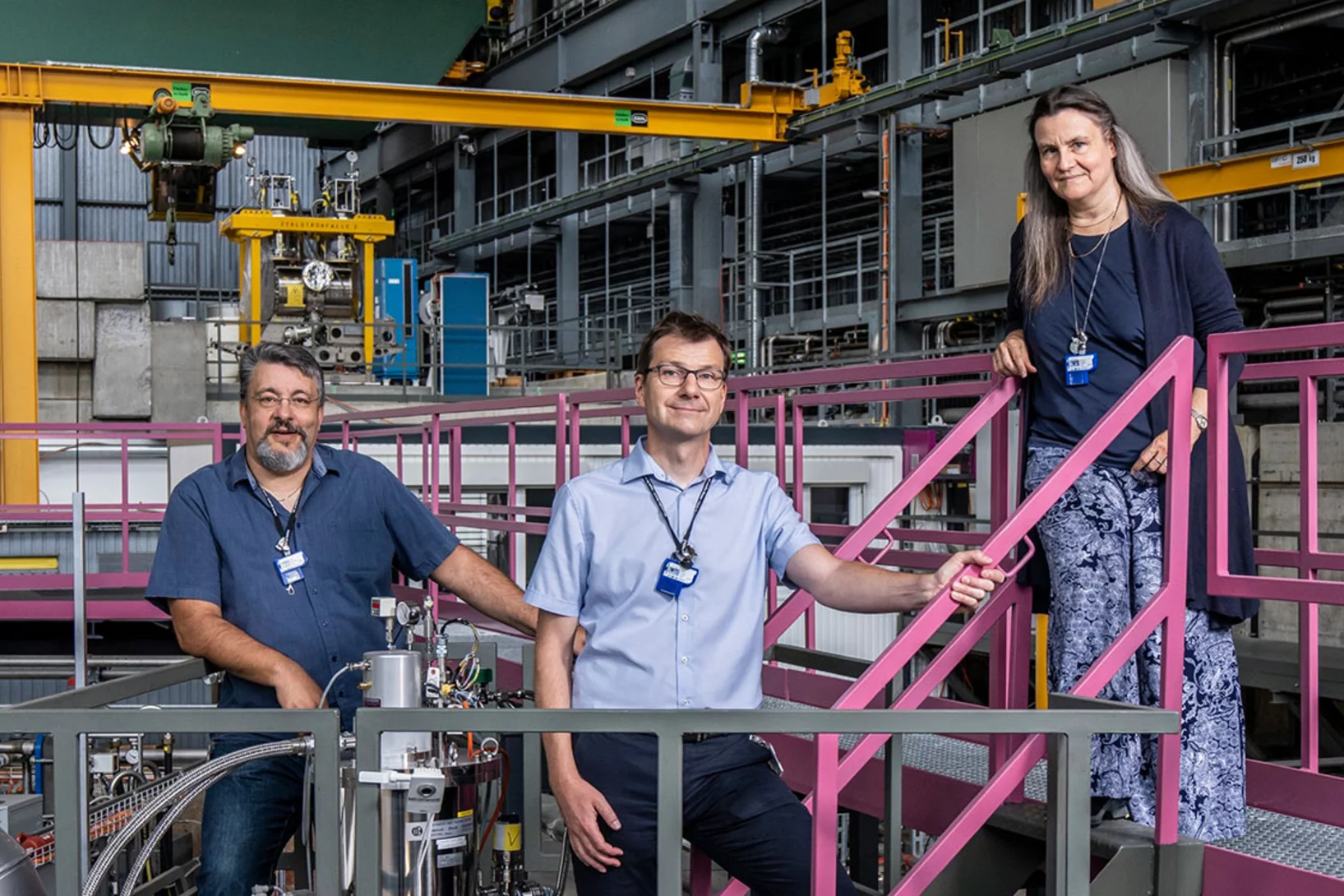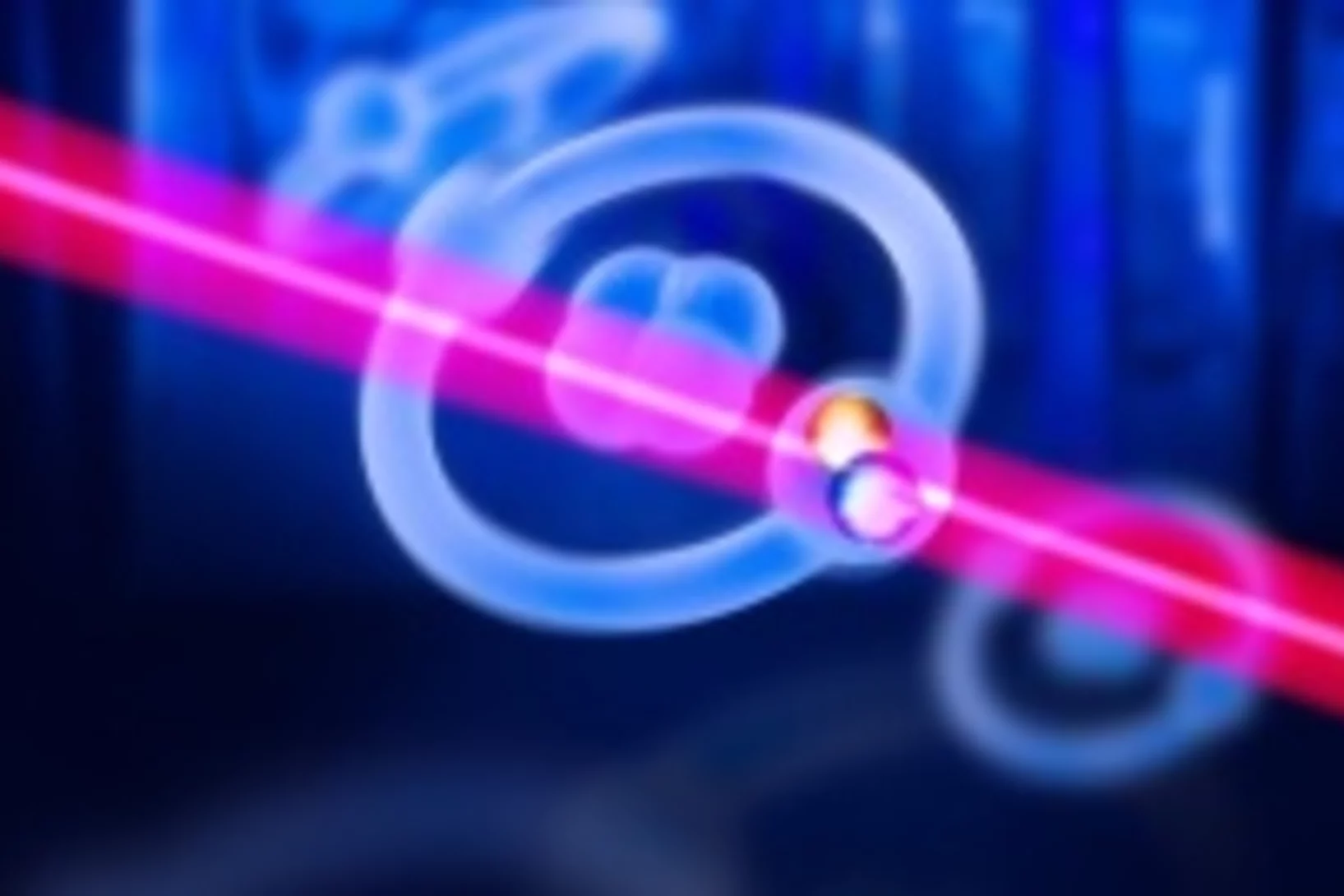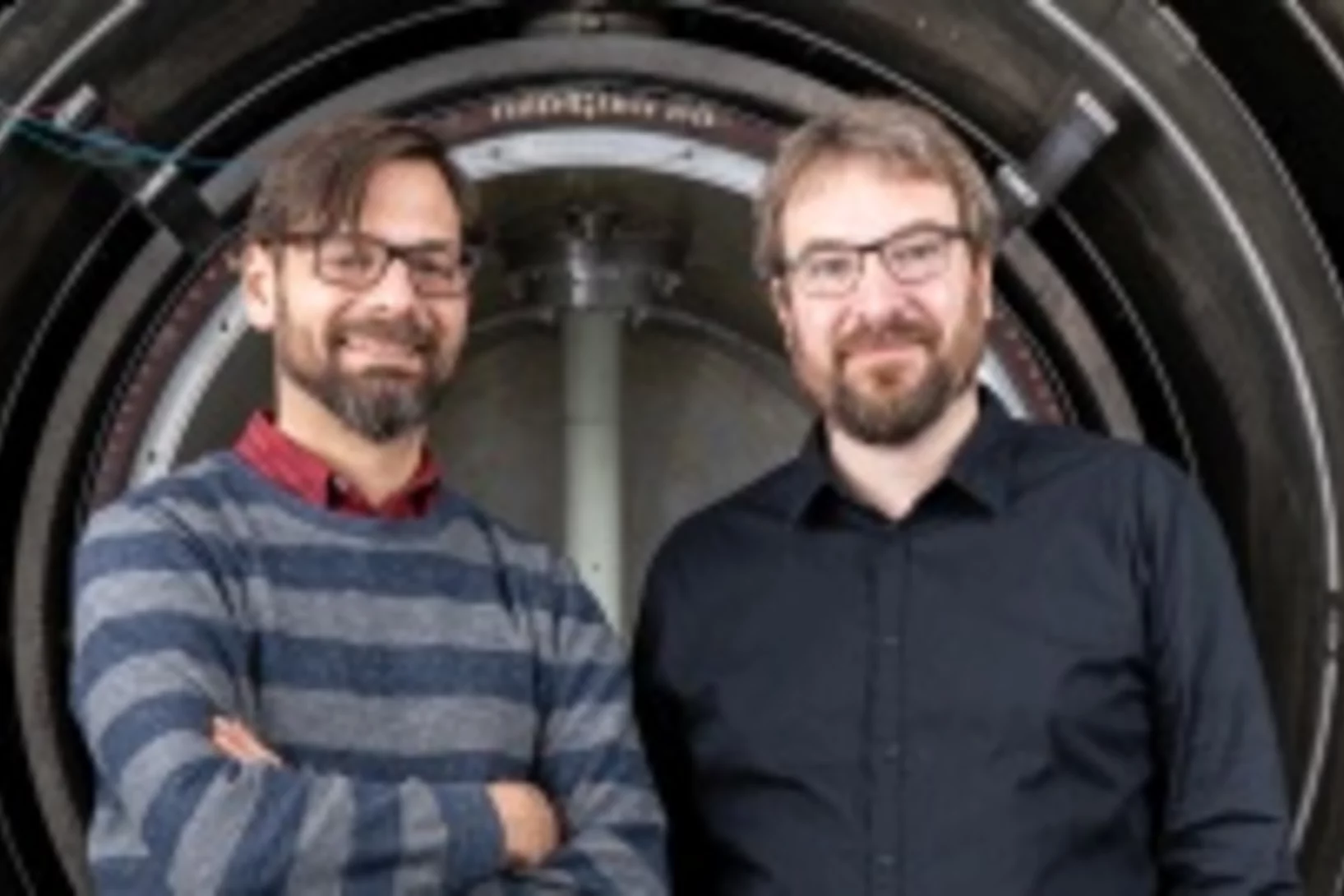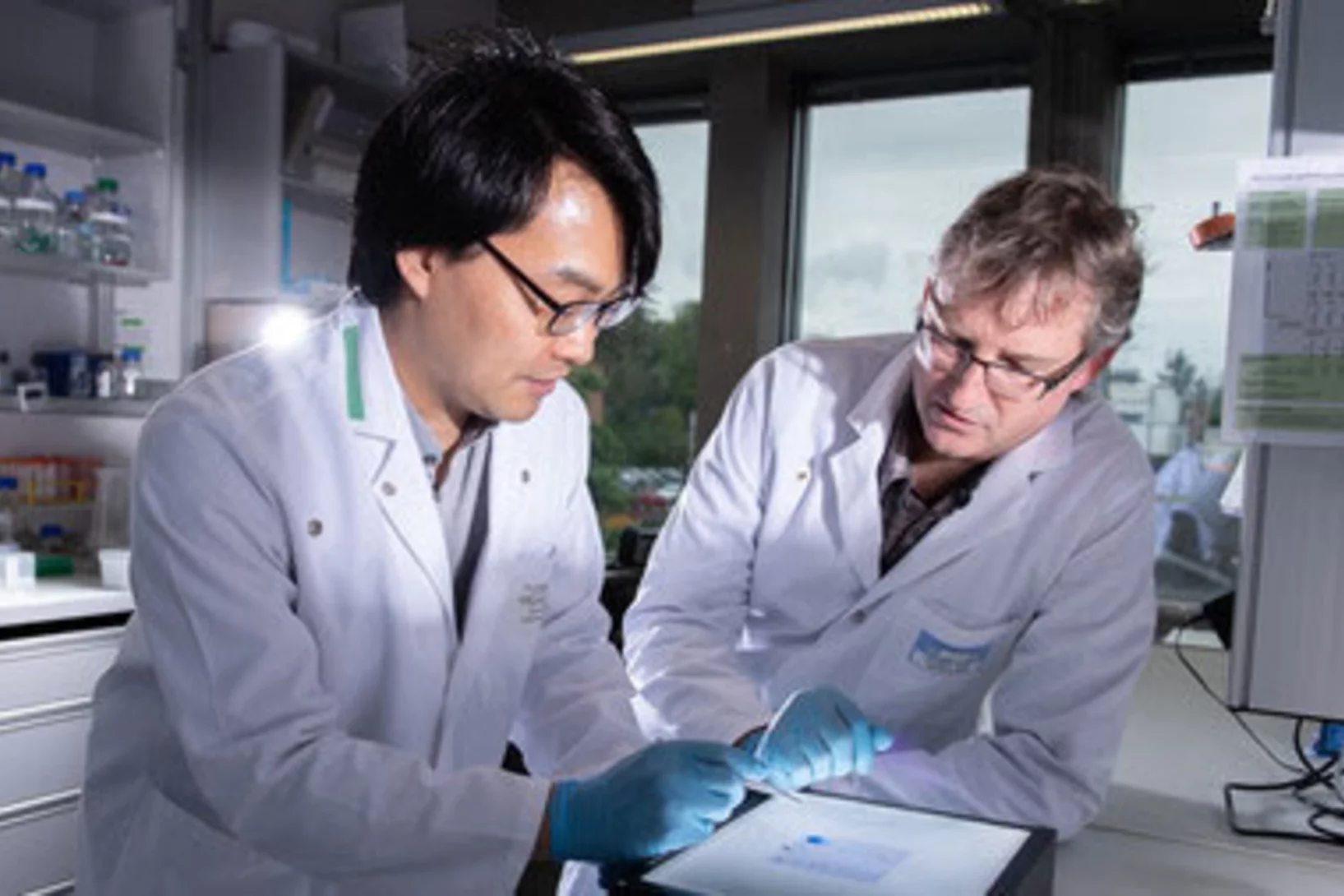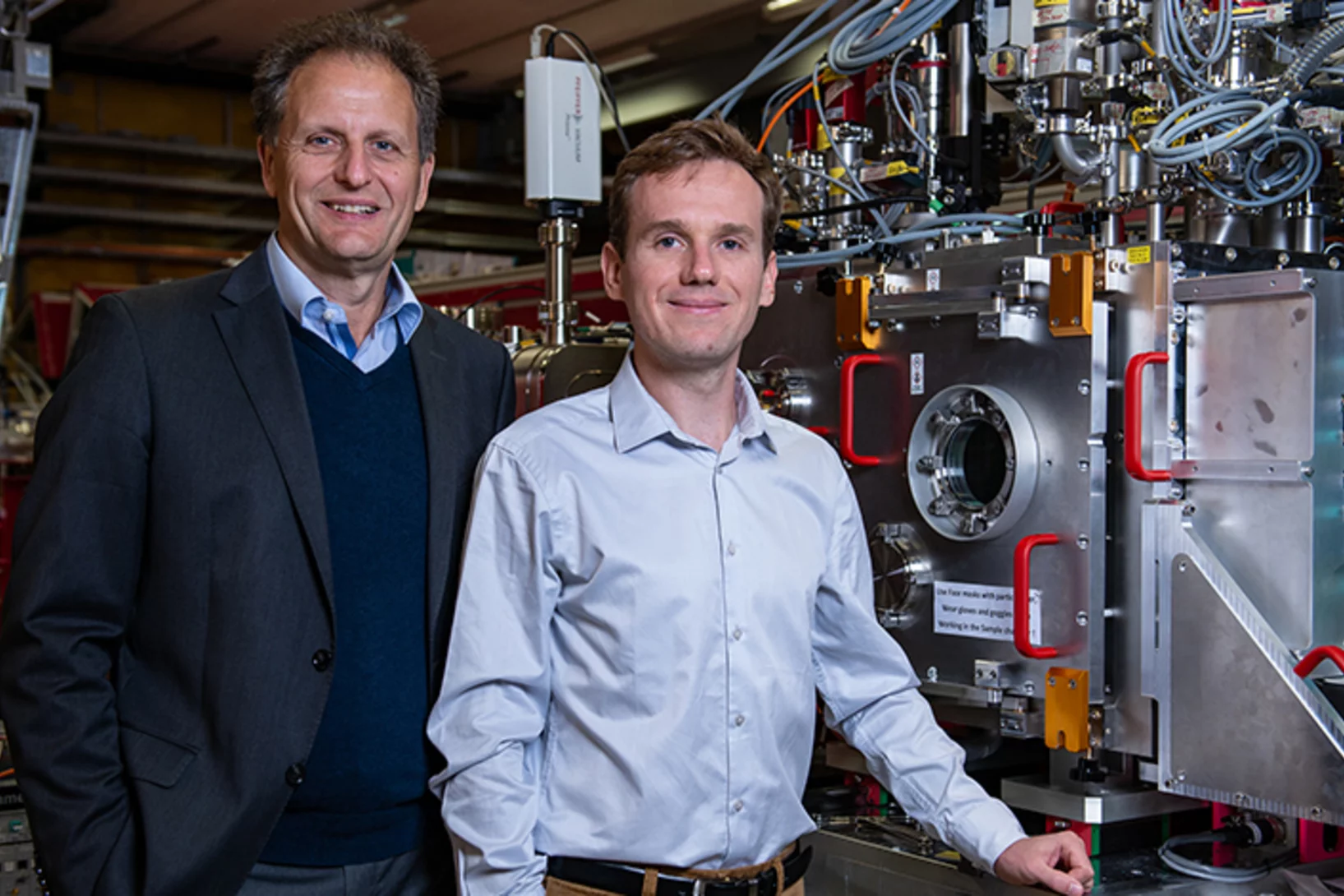Show filters
Carbocation, diradical, and superelectrophile in one molecule?
The pentafluorophenyl cation (C₆F₅⁺) breaks these rules with a borderline “crazy” reactivity.
Topological defects determine evolution of charge density wave phase transition
Total scattering signals collected at SwissFEL reveal the role of topological defects when switching properties of a charge density wave material. The defect formation and dynamics after laser excitation reveals new insights into the functionality of quantum materials.
Neue Massstäbe in der Kernphysik
Mit bislang unerreichter Präzision: PSI-Forschende vermessen den Kernradius von myonischem Helium-3 und stellen die Theorien der Atomphysik auf den Prüfstand.
Primer on X-ray magnetic circular dichroism
X-ray magnetic circular dichroism (XMCD) is a magneto-optical effect that describes the difference in absorption between left and right circularly polarized X-rays by a magnetized material. It has been widely applied to the study of magnetic systems and of magnetic phenomena and its unique capabilities make it a fundamental tool for the study of novel magnetic phenomena and new materials systems.
Defect structure controls the thermal magnetic switching rate of nano-sized metallic particles.
Past experiments done at the Paul Scherrer Institut, probed the thermal switching properties of nano-sized metallic magnetic particles
Generating a highly uniform magnetic field inside the magnetically shielded room of the n2EDM experiment
The central magnetic field of the n2EDM experiment based at PSI is of paramount importance for achieving the sensitivity goal. The necessary field homogeneity was recently demonstrated, as described here.
Mit Block, Bleistift und Algorithmen
Der PSI-Physiker Dominik Sidler entwickelt grundlegende Theorien für bislang unerklärbare Phänomene.
Prestigeträchtige Förderung für Forschung am PSI
Beton, chemische Katalyse und die Suche nach neuer Physik – für diese Forschungsthemen erhalten drei PSI-Forschende je einen Grant des Schweizerischen Nationalfonds.
Mapping the ecosystem of Wannier Functions software
A new review article, just published in Reviews of Modern Physics and highlighted on the journal cover, provides a map to the vast landscape of software codes that allow researchers to calculate Wannier functions, and to use them for materials properties predictions. The authors, from all over Europe and the USA, include two PSI scientists. After providing readers with the theoretical foundations on Wannier functions and their calculation, together with intuitive graphical schematics to explain what Wannier functions are, the authors map the existing Wannier codes and the key applications.
YBa1−𝑥Sr𝑥CuFeO5 layered perovskites: An attempt to explore the magnetic order beyond the paramagnetic-collinear-spiral triple point
Layered perovskites of general formula AA'CuFeO5 are characterized by the presence of spiral magnetic phases whose ordering temperatures 𝑇spiral can be tuned far beyond room temperature by introducing modest amounts of Cu/Fe chemical disorder in the crystal structure. This rare property makes these materials prominent candidates to host multiferroicity and magnetoelectric coupling at temperatures suitable for applications. Moreover, it has been proposed that the highest 𝑇spiral value that can be reached in this structural family ( ∼400 K) corresponds to a paramagnetic-collinear-spiral triple point with potential to show exotic physics. Since generating high amounts of Cu/Fe disorder is experimentally difficult, the phase diagram region beyond the triple point has been barely explored. To fill this gap we investigate here eleven YBa1−𝑥Sr𝑥CuFeO5 solid solutions (0≤𝑥≤1 ), where we replace Ba with Sr with the aim of enhancing the impact of the experimentally available Cu/Fe disorder. Using a combination of bulk magnetization measurements, synchrotron x-ray and neutron powder diffraction we show that the spiral state with 𝐤𝑠=(1/2,1/2,1/2±𝑞) is destabilized beyond a critical Sr content, being replaced by a fully antiferromagnetic state with ordering temperature 𝑇coll2≥𝑇spiral and propagation vector 𝐤𝑐2=(1/2,1/2,0). Interestingly, both 𝑇spiral and 𝑇coll2 increase with 𝑥 with comparable rates. This suggests a common, disorder-driven origin for both magnetic phases, consistent with theoretical predictions.
Fractional quasiparticles in three dimensions
Specific signatures of fractionalization have been observed in a three-dimensional system known as quantum spin ice.
Exact solution of the classical and quantum Heisenberg mean field spin glasses
We solve and elucidate the physics of quantum Heisenberg spins glasses, which governs the local moments in randomly doped, strongly correlated materials.
Die Rätsel der Proteine entschlüsseln
Der diesjährige Nobelpreis für Chemie geht an drei Forscher, die entscheidend dazu beigetragen haben, den Code der Proteine – wichtige Bausteine des Lebens – zu knacken. Doch damit aus diesem Wissen auch Anwendungen zum Beispiel in der Medizin entwickelt werden können, braucht es Forschungsinstitute wie das PSI.
Discovery of charge order above roomtemperature in the prototypical kagome superconductor La(Ru1−xFex)3Si2
The kagome lattice is an intriguing and rich platform for discovering, tuning and understanding the diverse phases of quantum matter, crucial for advancing modern and future electronics. Despite considerable efforts, accessing correlated phases at room temperature has been challenging.
Computational marathon matches the efficiency of the AiiDA platform with the power of Switzerland Alps supercomputer
A group of researchers from the LMS lab at PSI has conducted a "hero run" on the new Swiss supercomputer, occupying it entirely for about 20 hours with calculations managed remotely by the AiiDA software tools. The run demonstrated the efficiency and stability of AiiDA, that could seamlessly fill the entire capacity of an exascale machine, as well as the performance of the Alps supercomputer, that has been just inaugurated. All the results will soon be published on the Materials Cloud.
«Magisches» Element stellt Modell zur Kernsynthese in Sternen infrage
Überraschende Messungen führen auf die Spur eines unbekannten Prozesses.
Einmalig präzise: Neuer Wert für die Halbwertszeit von Samarium-146
Forscherinnen und Forscher des PSI und der Australian National University haben die Halbwertszeit von Samarium-146 sehr genau bestimmt.
Nature’s sunscreen and other SwissFEL stories
From DNA repair to catalysts: how the Alvra experimental station at SwissFEL has developed into a special tool for biology and chemistry research.
Eine Bionanomaschine für grüne Chemie
PSI-Forschende haben ein einzigartiges Enzym aus Bakterien charakterisiert, das eine wichtige chemische Reaktion möglich macht.
Charge fractionalisation observed spectroscopically
Quantum mechanics tells us that the fundamental unit of charge is unbreakable – but exceptions exist.
Altermagnetism proves its place on the magnetic family tree
Experiments at the Swiss Light Source SLS prove the existence of a new type of magnetism, with broad implications for technology and research.
Erbschäden mit Sonnenlicht reparieren
Ein internationales Forschungsteam hat am SwissFEL des PSI aufgeklärt, wie ein Enzym mithilfe von Sonnenlicht DNA-Schäden repariert.
The secret life of an electromagnon
SwissFEL sheds light on how lattice and atomic spins jiggle together.
A gold standard for computational materials science codes
The most comprehensive verification effort so far on computer codes for materials simulations.
Eintauchen ins Zellskelett
Das Zellskelett ist ein kleines Wunderwerk. Seine Erforschung verspricht unter anderem neue Therapiemöglichkeiten gegen Krebs.
Geheimnisse des Gehirns entschlüsseln
Ort für Spitzenforschung: Forschende des PSI erhalten umfassende Förderung für ihre Hirnforschung durch die amerikanischen NIH.
Rätsel der Mikrogele gelöst
Forschende des PSI und der Universität Barcelona können das merkwürdige Schrumpfen von Mikrogelen experimentell erklären.
Hairy cells: How cilia’s motor works
Understanding this motion may help to tackle health problems that affect cilia, which range from fertility issues to lung disease and COVID-19.
Mirror, mirror on the wall…
…. Now we know there are chiral phonons for sure
Ein Algorithmus für schärfere Protein-Filme
Mit einem neu entwickelten Algorithmus lassen sich Messungen an Freie-Elektronen-Röntgenlasern effizienter auswerten.
Die Jagd nach dem Protonenradius
0,000 000 000 000 000 840 87 (39) Meter – diese erstaunliche Zahl fanden Forschende am PSI für den Radius eines Protons.
So beginnt das Sehen
PSI-Forschende haben untersucht, was als Allererstes im Auge abläuft, wenn Licht auf die Netzhaut trifft.
2 Millionen Förderung für die Suche nach neuer Physik
Philipp Schmidt-Wellenburg wird an einer Myonenstrahllinie des PSI ein neuartiges Experiment aufbauen.
CNRS movie on n2EDM
Our French collaborators and CNRS produced an excellent short movie about our common n2EDM experiment. The apparatus is currently being set up in
UCN Area South. The collaboration is on track for commissioning of the apparatus with neutrons towards the end of 2022.
How to get chloride ions into the cell
A molecular movie shot at PSI reveals the mechanism of a light-driven chloride pump
Mehr Einblick in den Sehsinn
PSI-Forschende haben die Struktur eines wichtigen Bestandteils im Auge aufgeklärt: Der Ionenkanal CNG sorgt dafür, dass das Sehsignal ins Gehirn weitergeleitet werden kann.
Quantum billiards with correlated electrons
Our collaborators at the Jozef Stefan Institute – the leading author, Jan Ravnik, is now a PSI Fellow at LMN – report a study of the electron ordering in equilateral triangle structures via photoexcitation of the prototypical dichalcogenide 1T-TaS2.
A time-domain phase diagram of metastable quantum states
Our collaborators at the Jozef Stefan Institute – the leading author, Jan Ravnik, is now a PSI Fellow at LMN – report a ‘dynamical’ phase diagram of metastable quantum states generated via photoexcitation of the prototypical dichalcogenide material 1T-TaS2.
Die Schweizer Forschungsinfrastruktur für Teilchenphysik CHRISP
Forschende suchen nach Abweichungen im gängigen Standardmodell der Physik und wollen herausfinden, wie unser Universum aufgebaut ist.
Grösse des Heliumkerns genauer gemessen als je zuvor
In Experimenten am Paul Scherrer Institut PSI hat eine internationale Forschungszusammenarbeit den Radius des Atomkerns von Helium fünfmal präziser gemessen als jemals zuvor. Mithilfe des neuen Werts lassen sich fundamentale physikalische Theorien testen.
Magnetisch abgeschirmt vom Rest der Welt
Am Paul Scherrer Institut PSI haben Forschende gemeinsam mit einer Firma einen Raum konstruiert, der einer der am besten magnetisch abgeschirmten Orte auf der Erde ist. Mit seiner Hilfe wollen sie einige der letzten Rätsel der Materie lösen und der Antwort auf eine fundamentale Frage näher kommen: Warum gibt es überhaupt Materie und damit auch uns selbst?
Unerwartetes Aufwölben eines Proteins
Forschende haben dem lebenswichtigen Protein Cytochrom C ein Geheimnis entlockt, das dieses bisher gut zu verbergen wusste. Messungen am Freie-Elektronen-Röntgenlaser SwissFEL zeigen Strukturänderungen, welche die Wissenschaft für diese Art von Biomolekül bisher ausgeschlossen hatten.
Efficient analysis method for multiplet lines in Fourier space
In his first paper as lead author, LMN PhD student Adrian Beckert and co-authors demonstrate an algorithm which takes advantage of peak multiplicity to retrieve line shape information. The results were published in Optics Express and are relevant to a wide range of topics, ranging from neutron-scattering to spectroscopy of rare-earth doped solids.
Auf der Suche nach einer neuen Physik
Mit dem Hochintensitäts-Protonenbeschleuniger HIPA erzeugt das Paul Scherrer Institut Elementarteilchen, um zu klären, wie das Universum aufgebaut ist. Mithilfe von Pionen, Myonen und Neutronen führen die Forschenden Experimente durch, um das Standardmodell der Elementarteilchenphysik zu überprüfen.
Langlebiges pionisches Helium: exotische Materie erstmals experimentell nachgewiesen
Exotische Atome, in denen Elektronen durch andere Teilchen ersetzt werden, ermöglichen tiefe Einblicke in die Quantenwelt. Nach acht Jahren gelang einer internationalen Gruppe von Forschenden an der Pionenquelle des PSI ein schwieriges Experiment: Sie schufen ein künstliches Atom, sogenanntes «pionisches Helium».
Dem Rätsel der Materie auf der Spur
Forschende haben an der Quelle für ultrakalte Neutronen des PSI eine Eigenschaft des Neutrons so genau wie noch nie vermessen: sein elektrisches Dipolmoment. Denn bis heute wird nach einer Erklärung gesucht, weshalb es nach dem Urknall mehr Materie als Antimaterie gab.
Molekulare Schere stabilisiert das Zell-Zytoskelett
Forschende des Paul Scherrer Instituts PSI haben einen wichtigen Teil des Kreislaufs identifiziert, der den Auf- und Abbau des Zellskelettes reguliert. Dazu beobachteten sie mithilfe der Synchrotron Lichtquelle Schweiz SLS Molekül-Scheren bei der Arbeit.
Diesmal ganz Bio: SwissFEL macht Proteinstrukturen sichtbar
Für die Entwicklung neuer medizinischer Wirkstoffe ist auch die genaue Kenntnis von Proteinen entscheidend. In einem Pilotexperiment haben Forschende jetzt erstmals den Freie-Elektronen-Röntgenlaser SwissFEL des PSI zur Untersuchung von Proteinkristallen genutzt.

